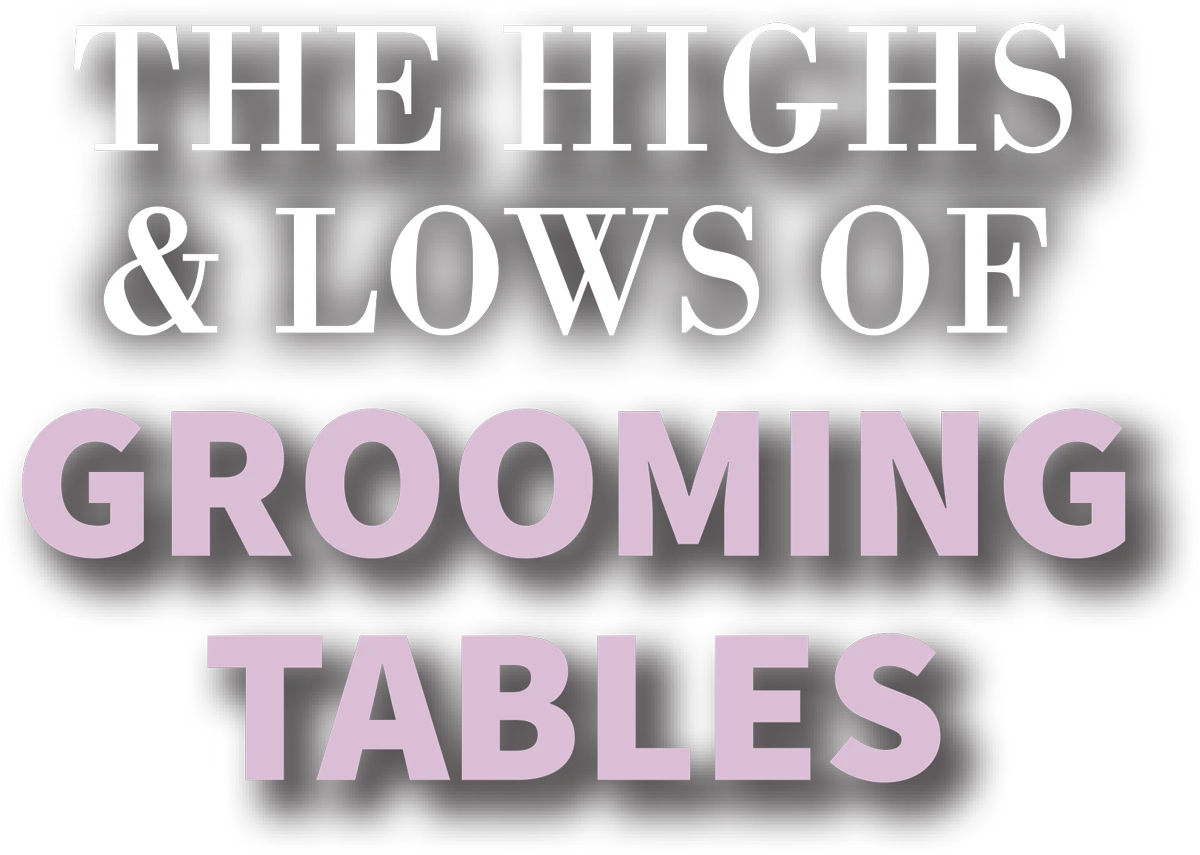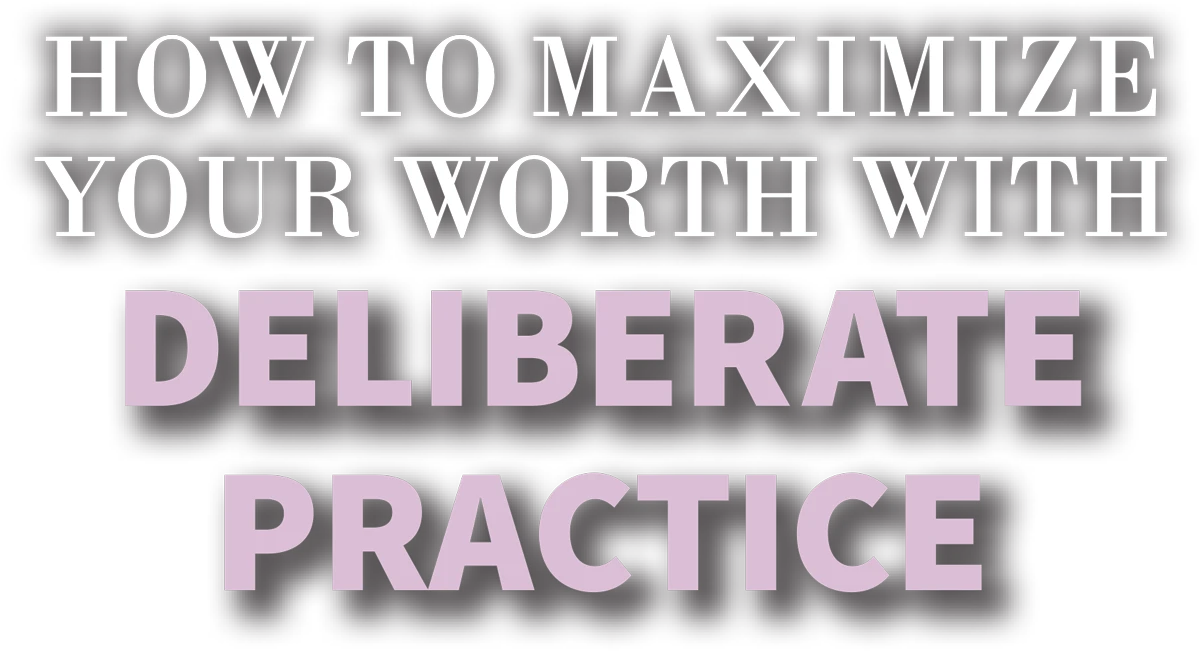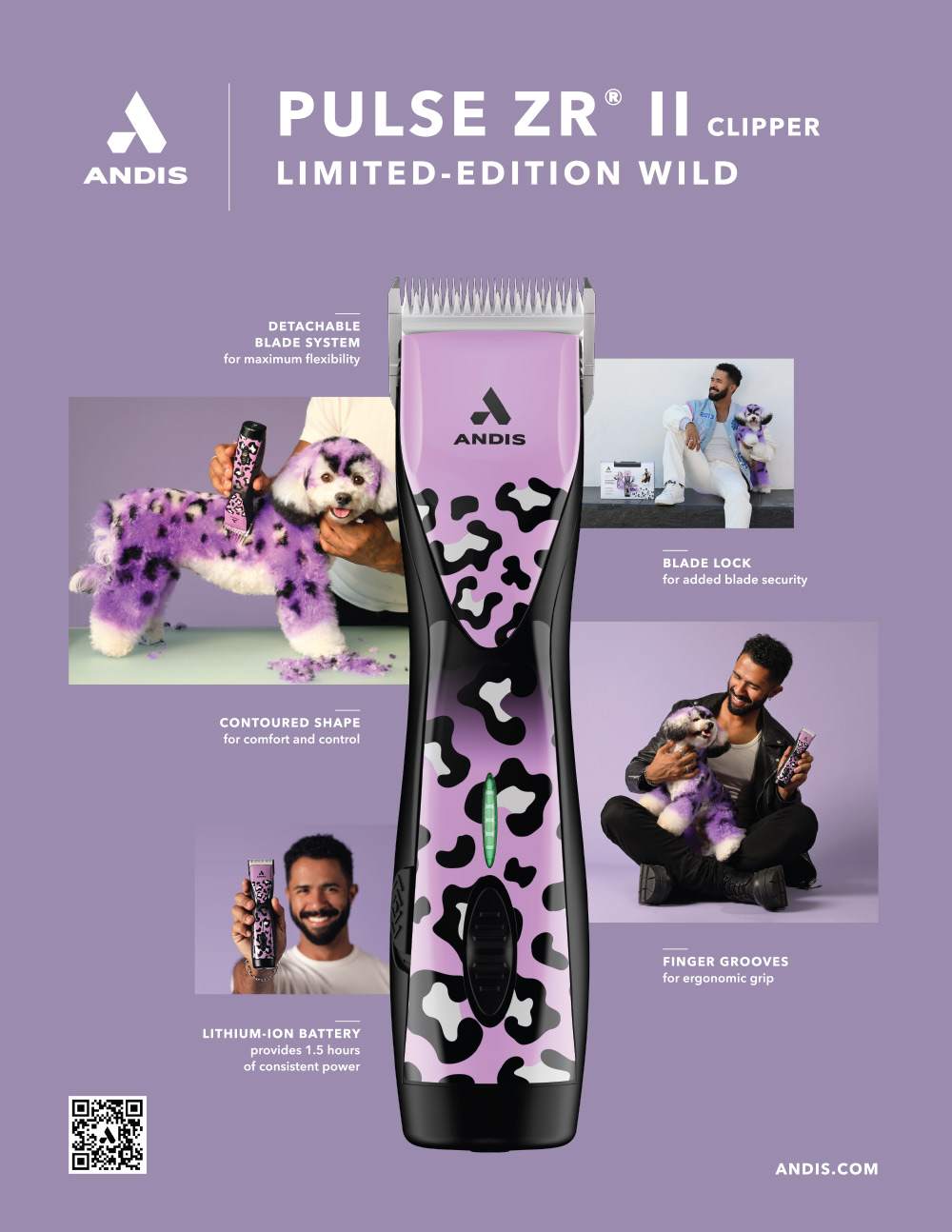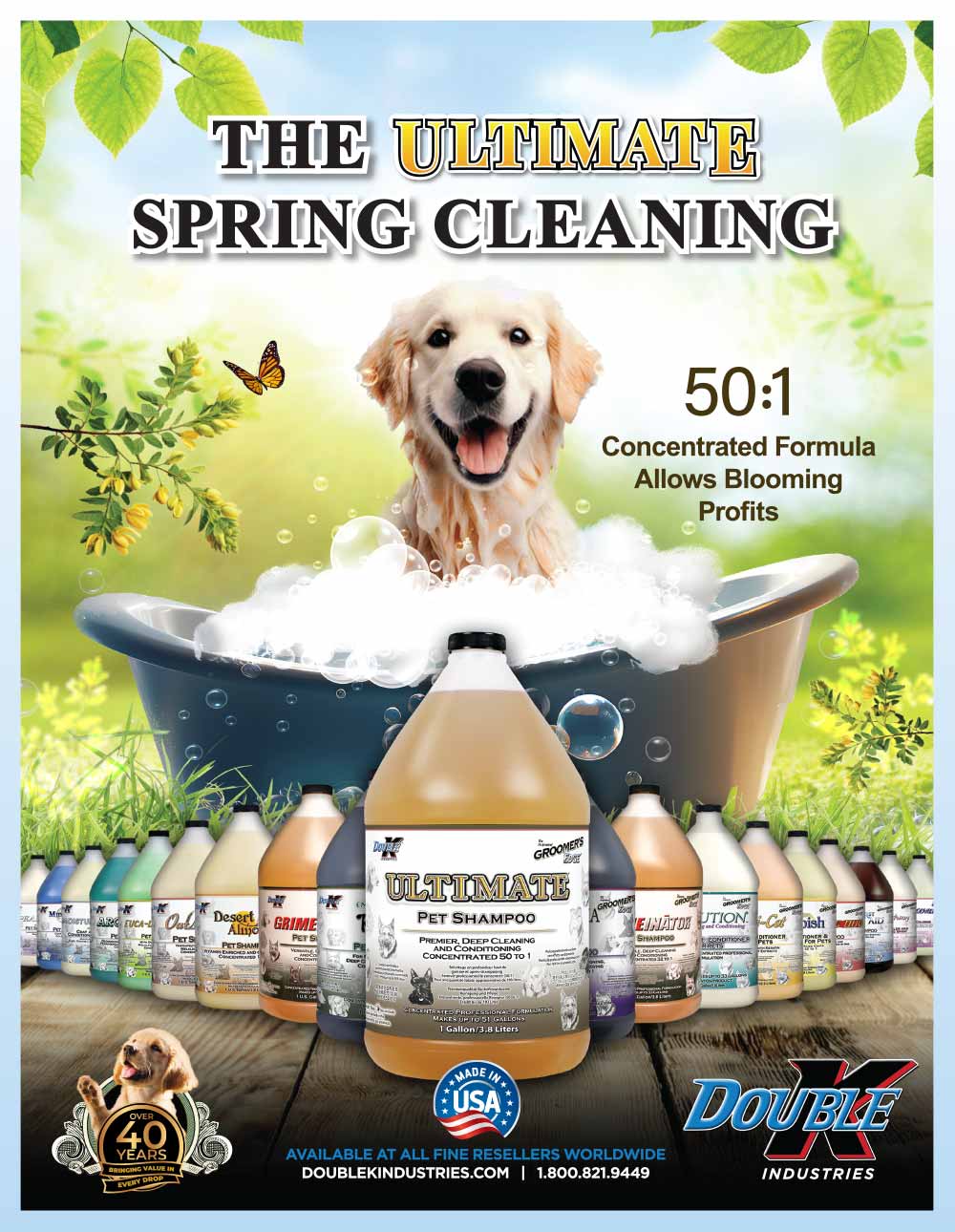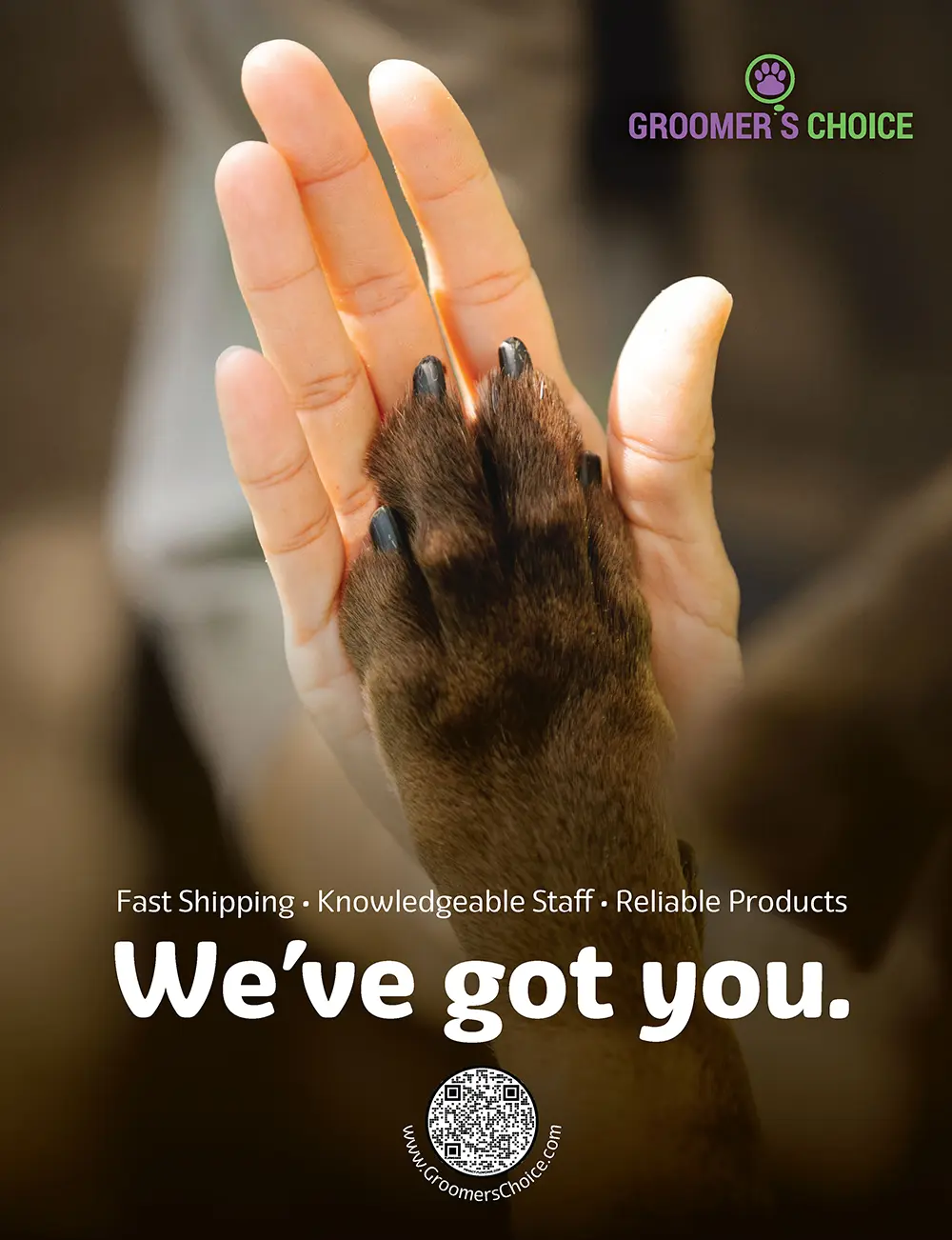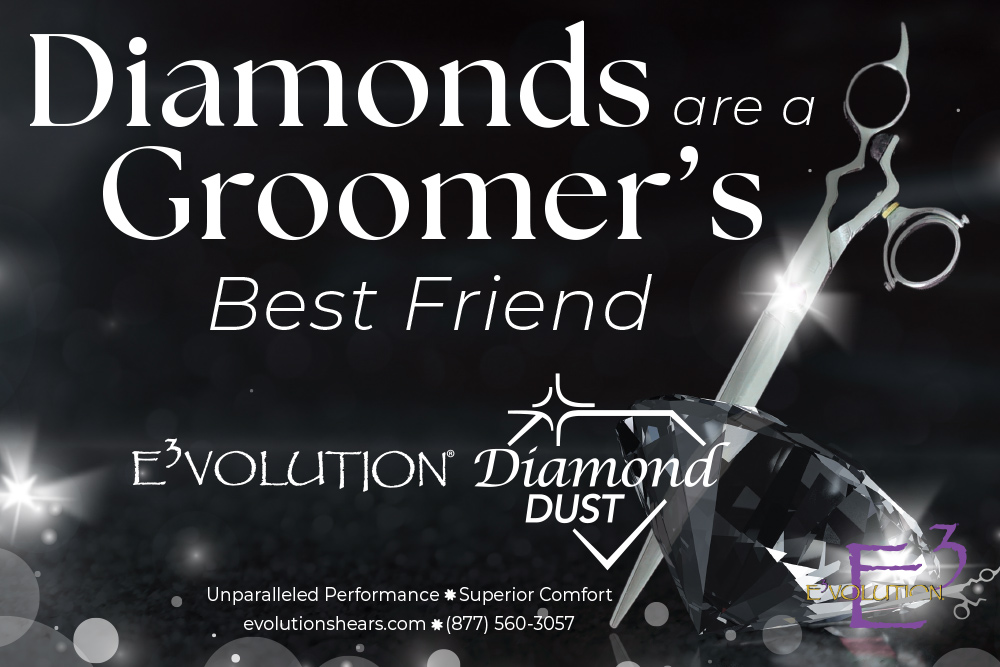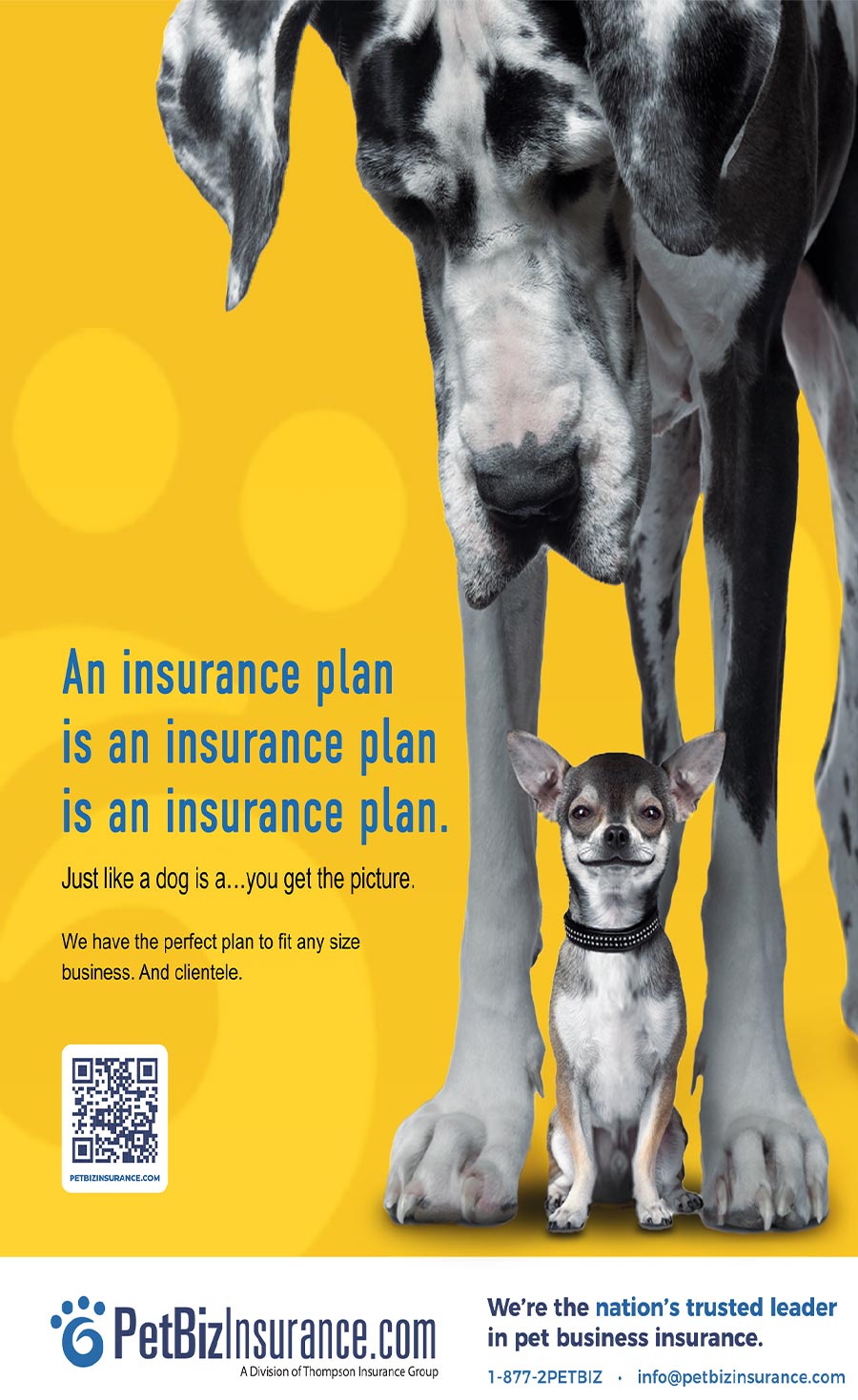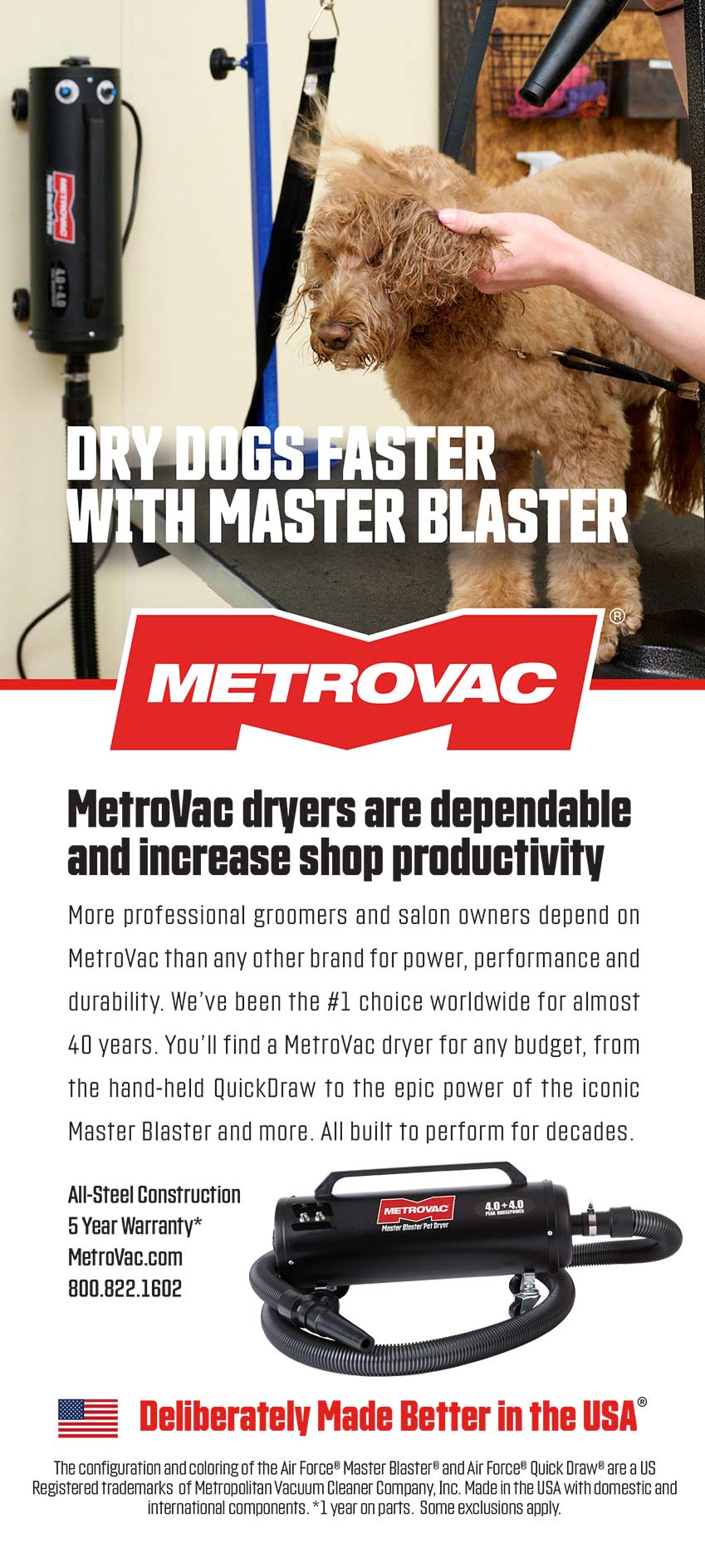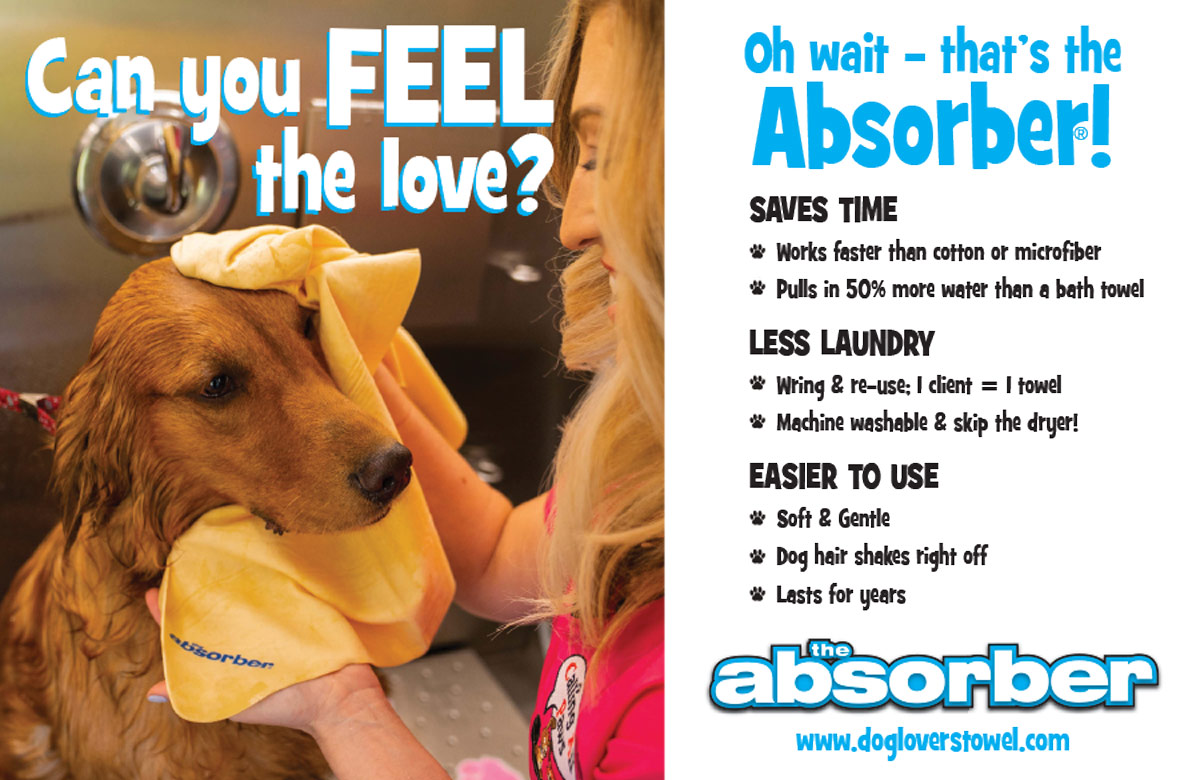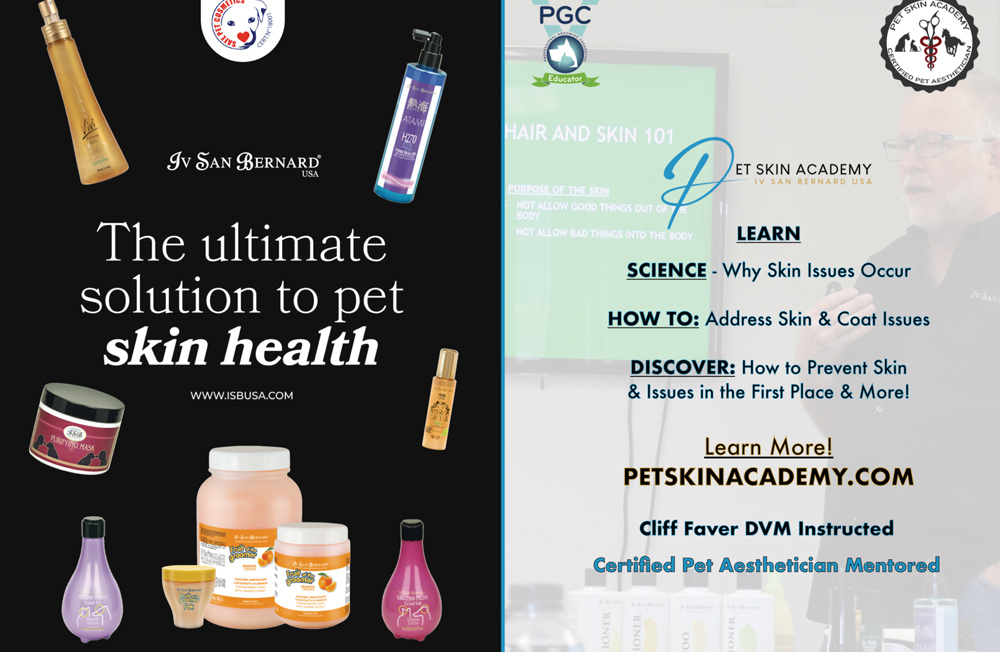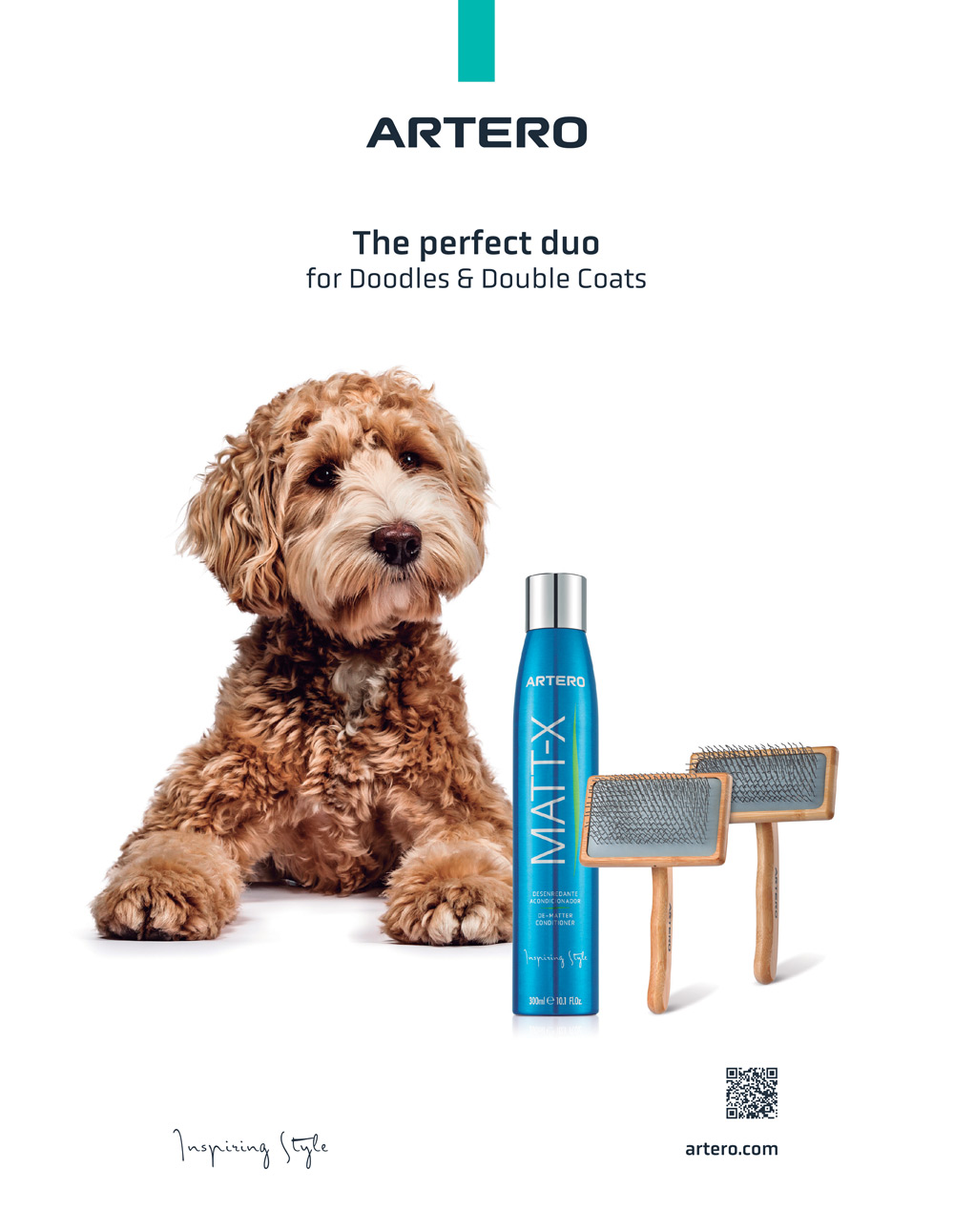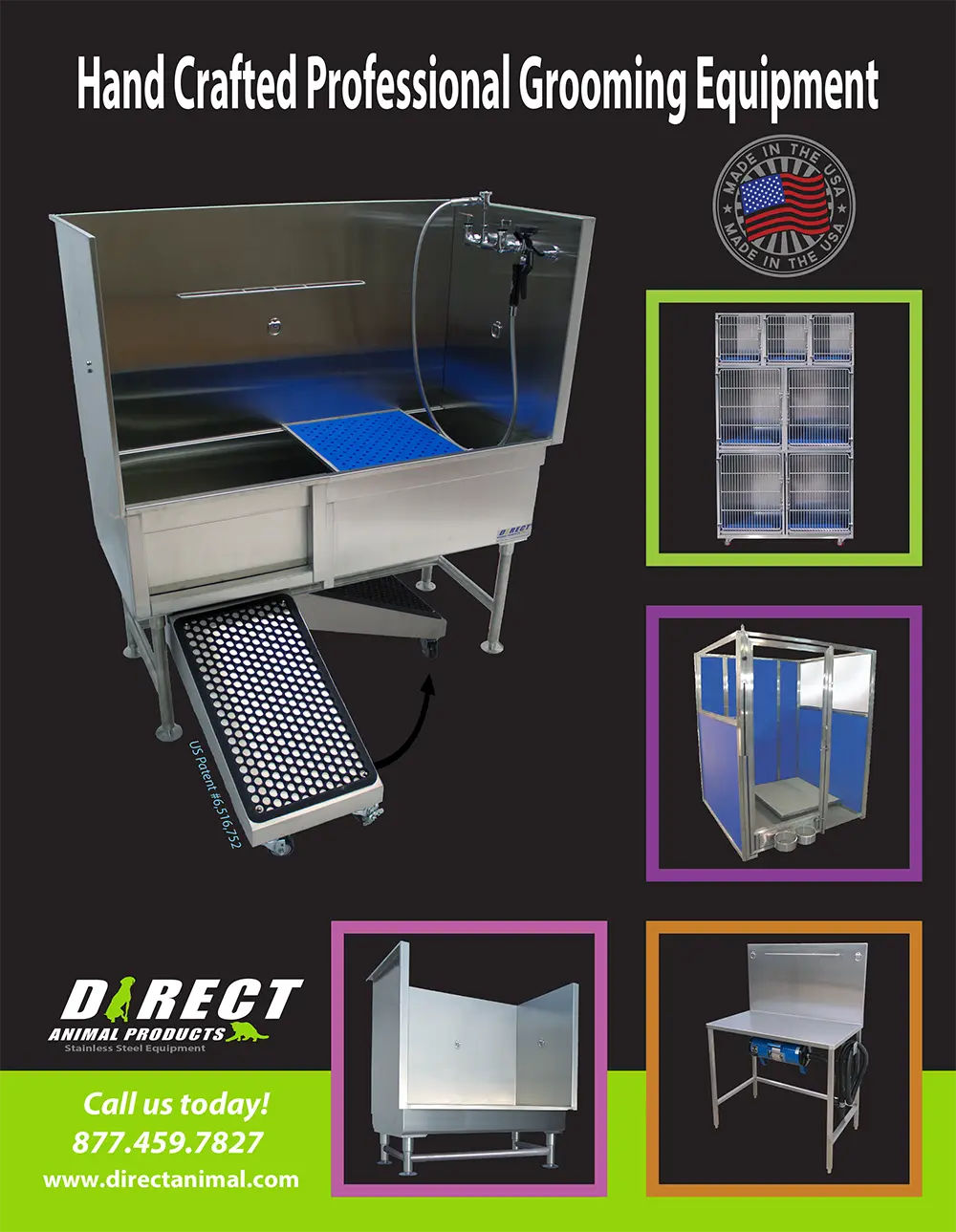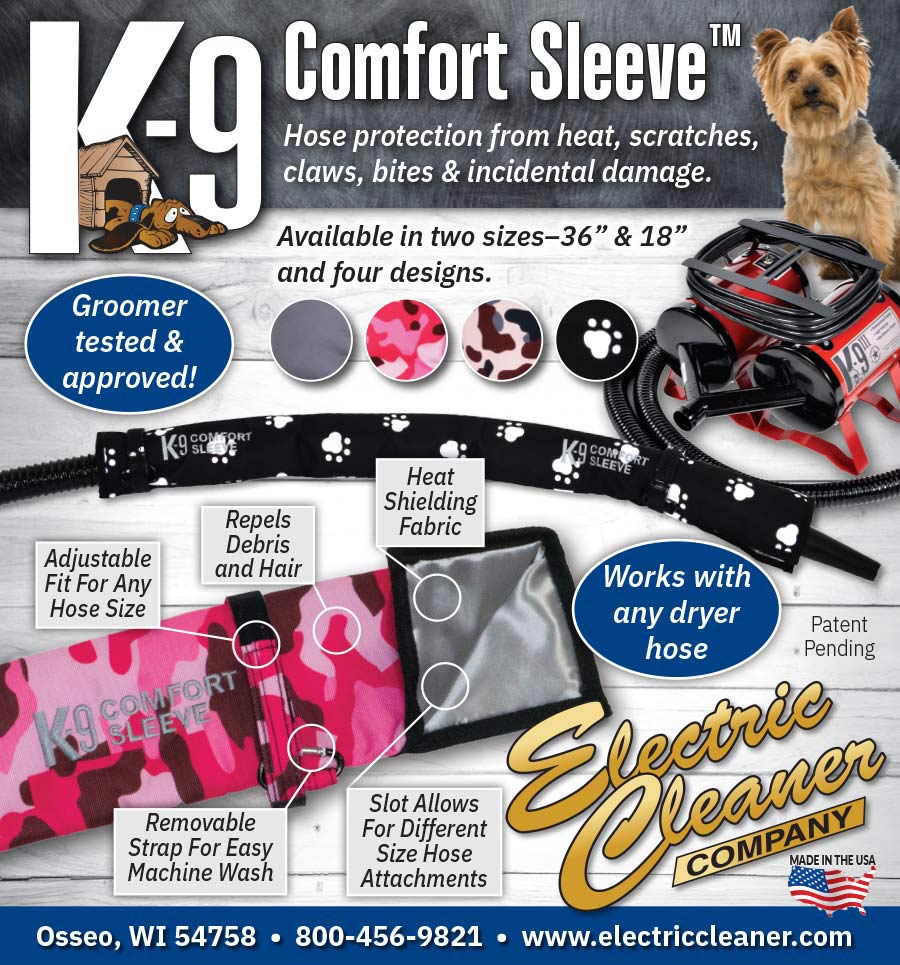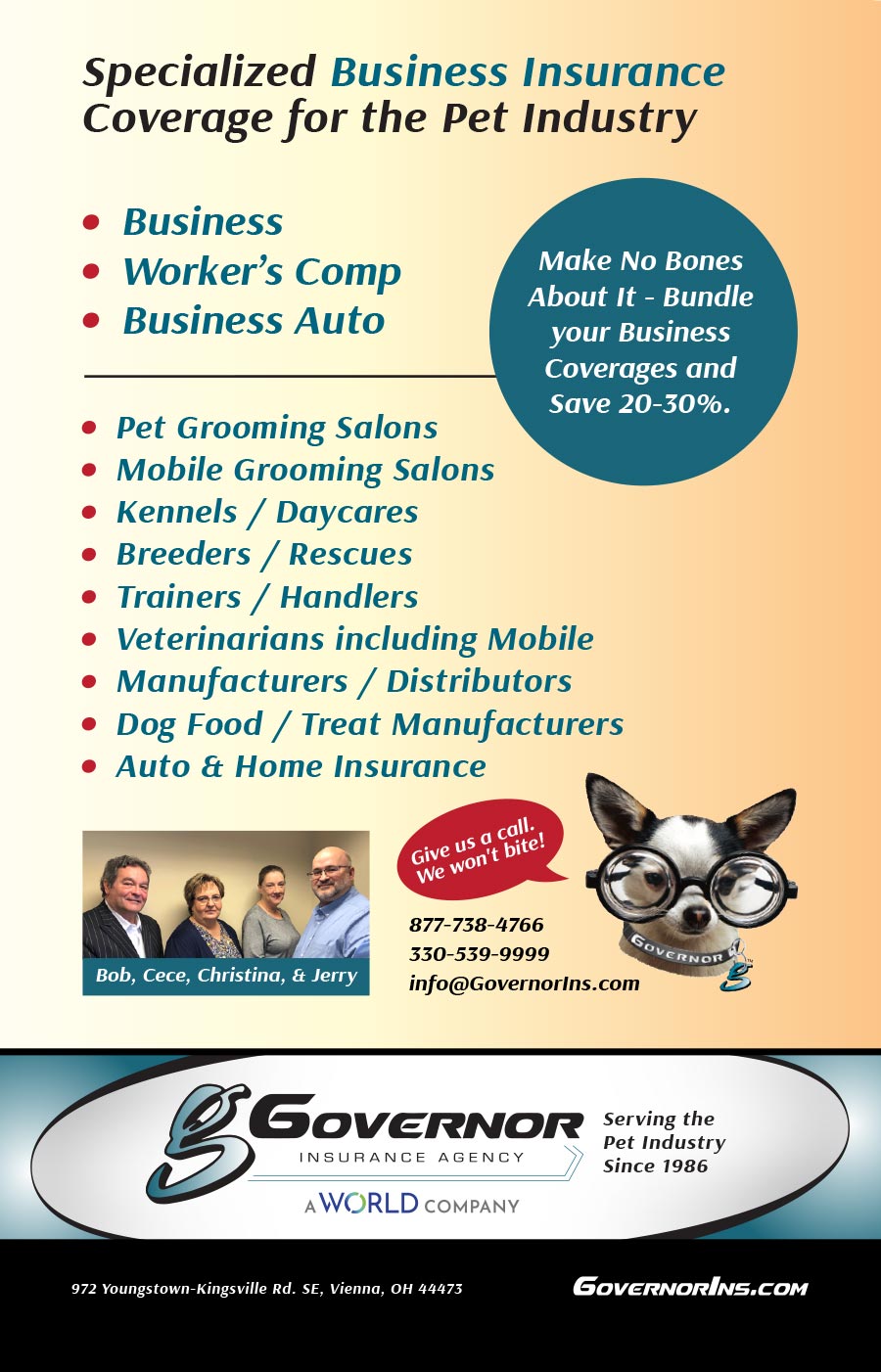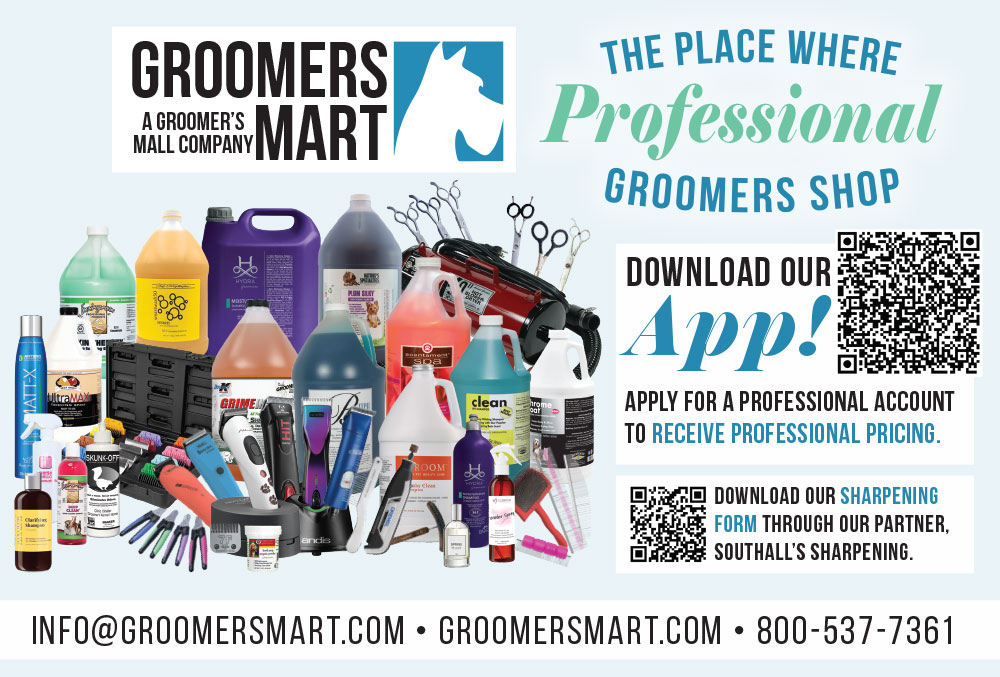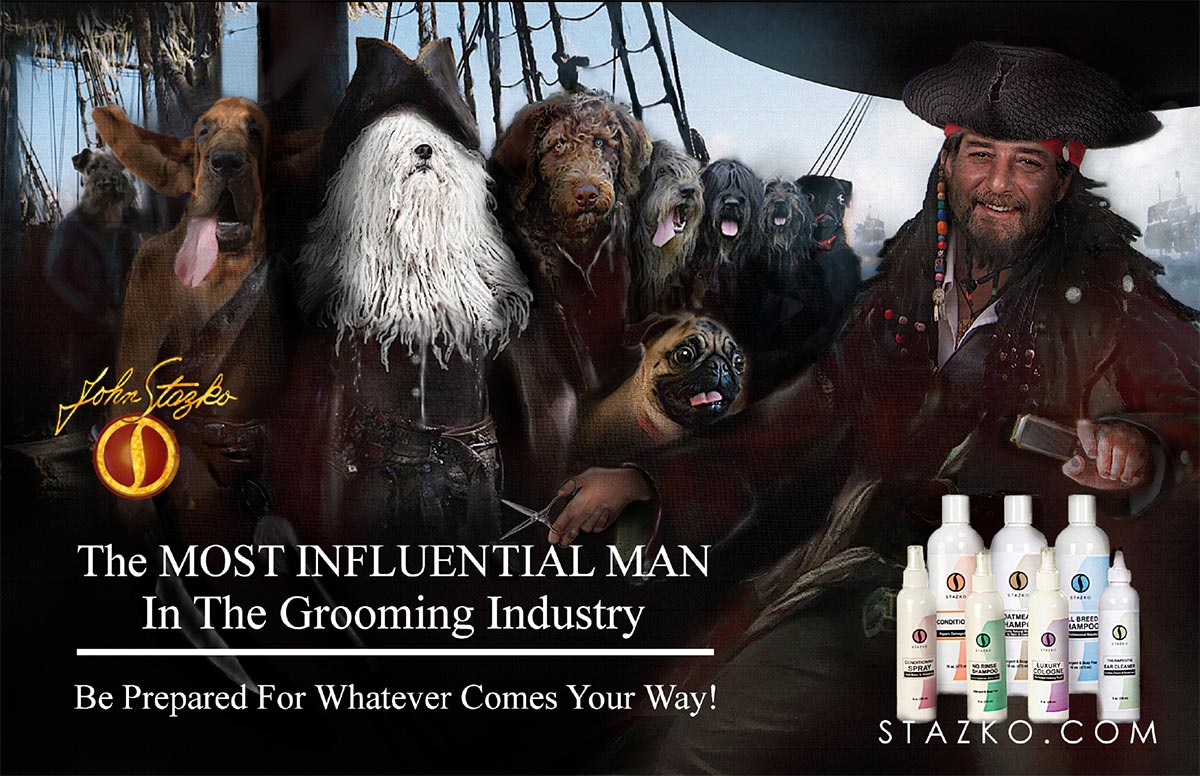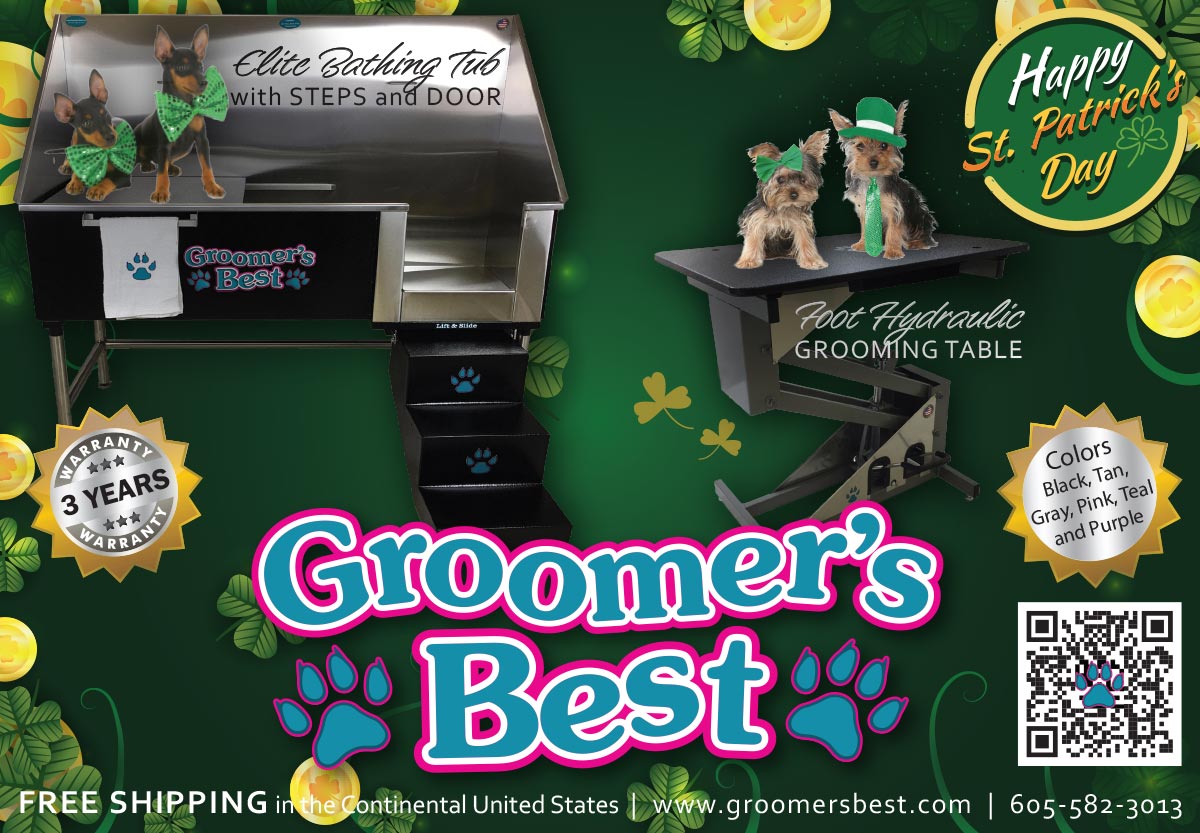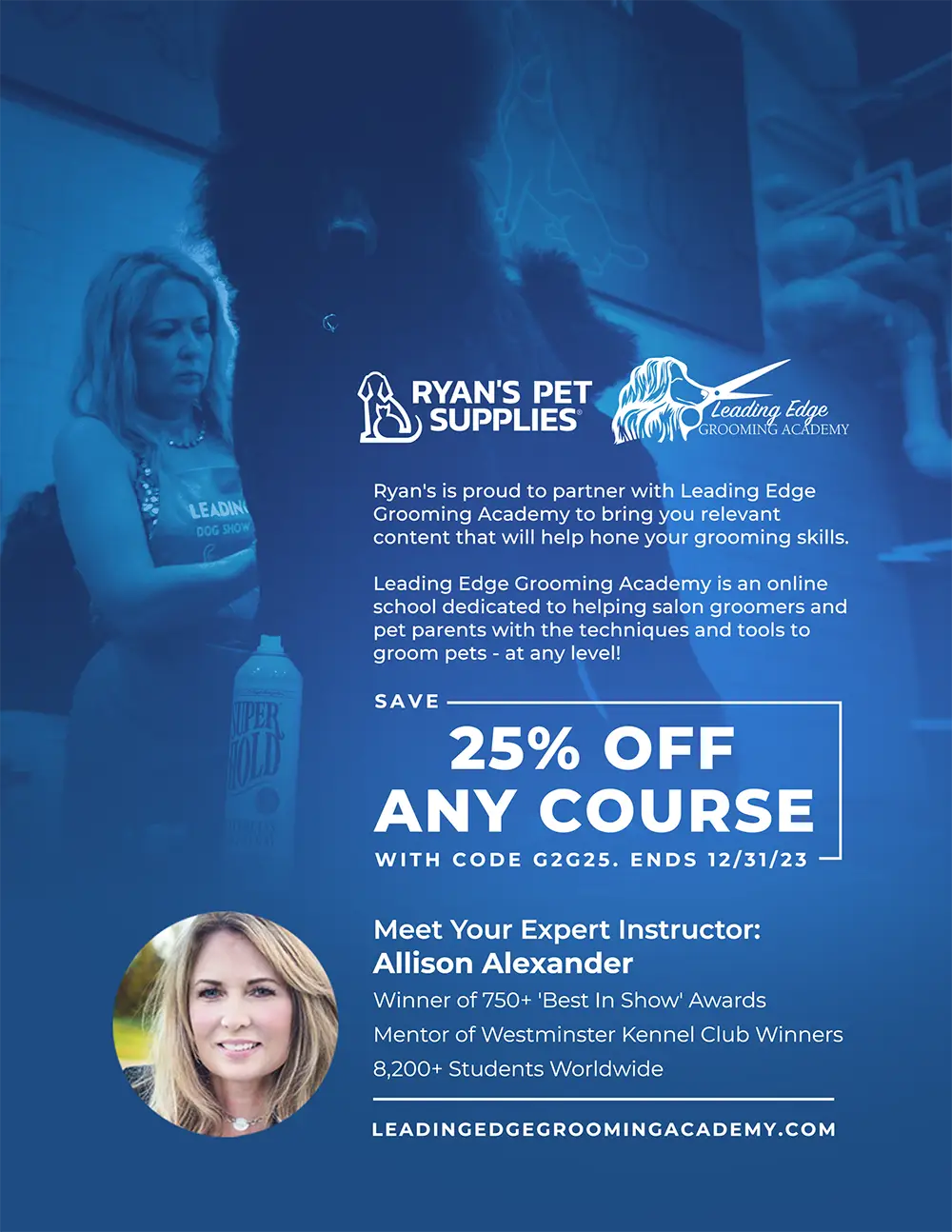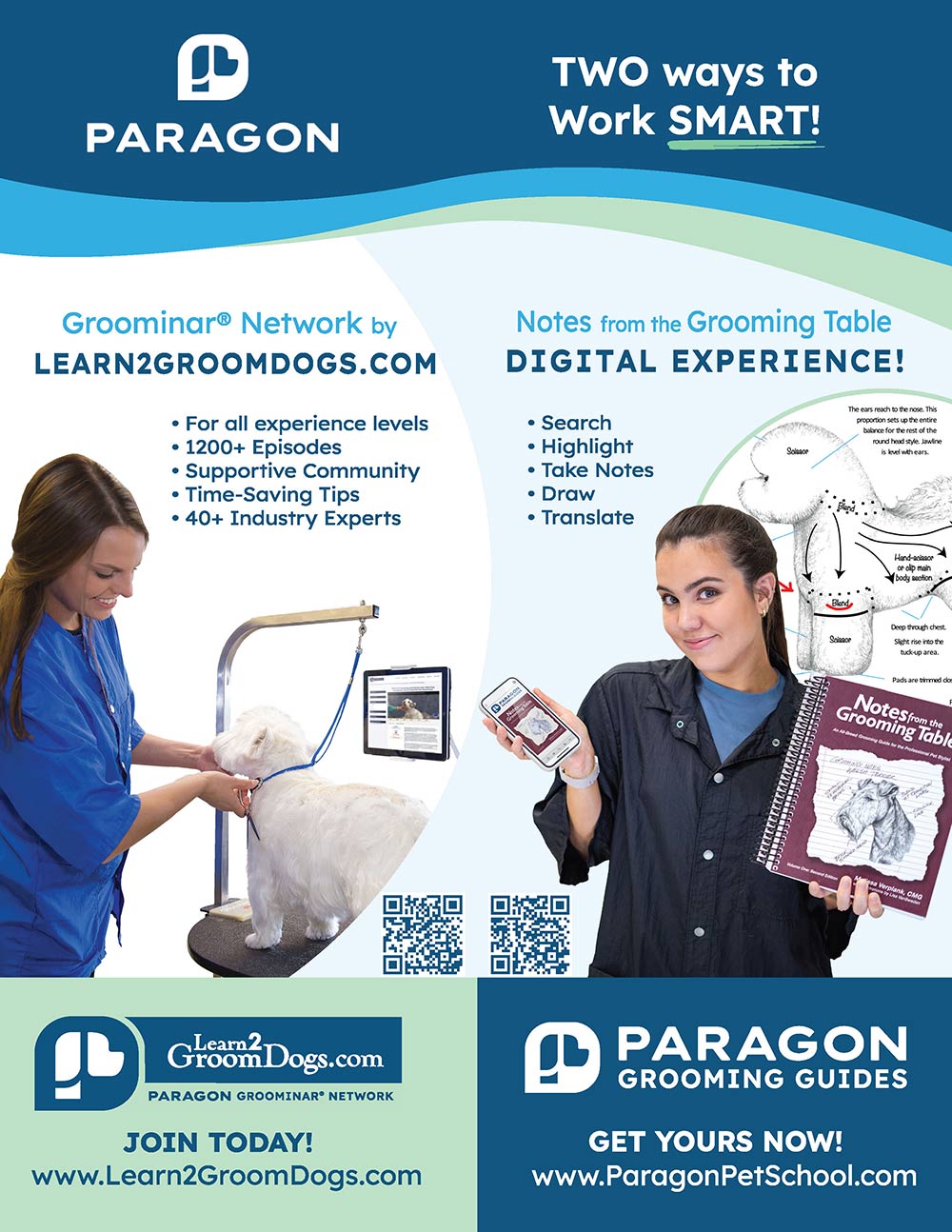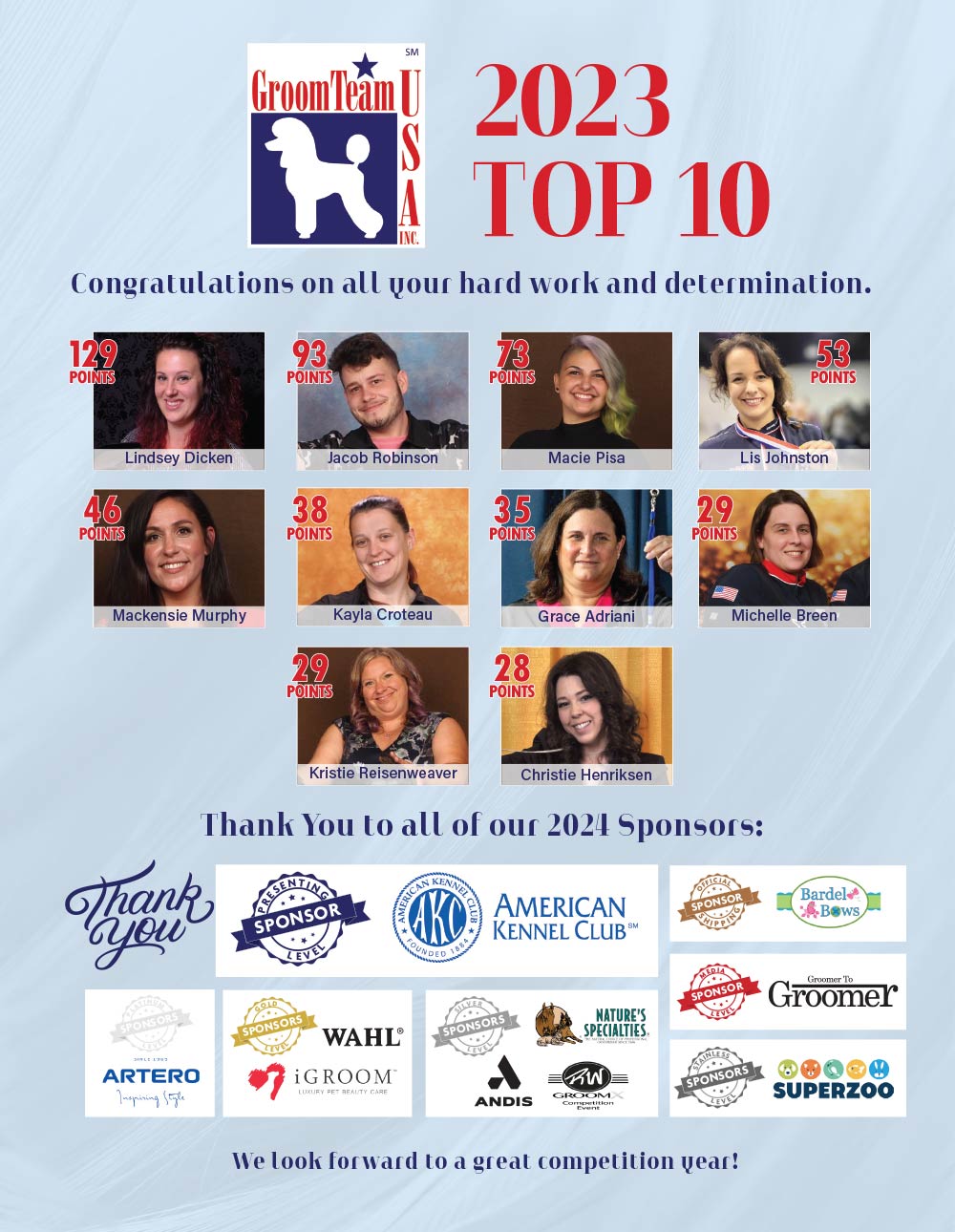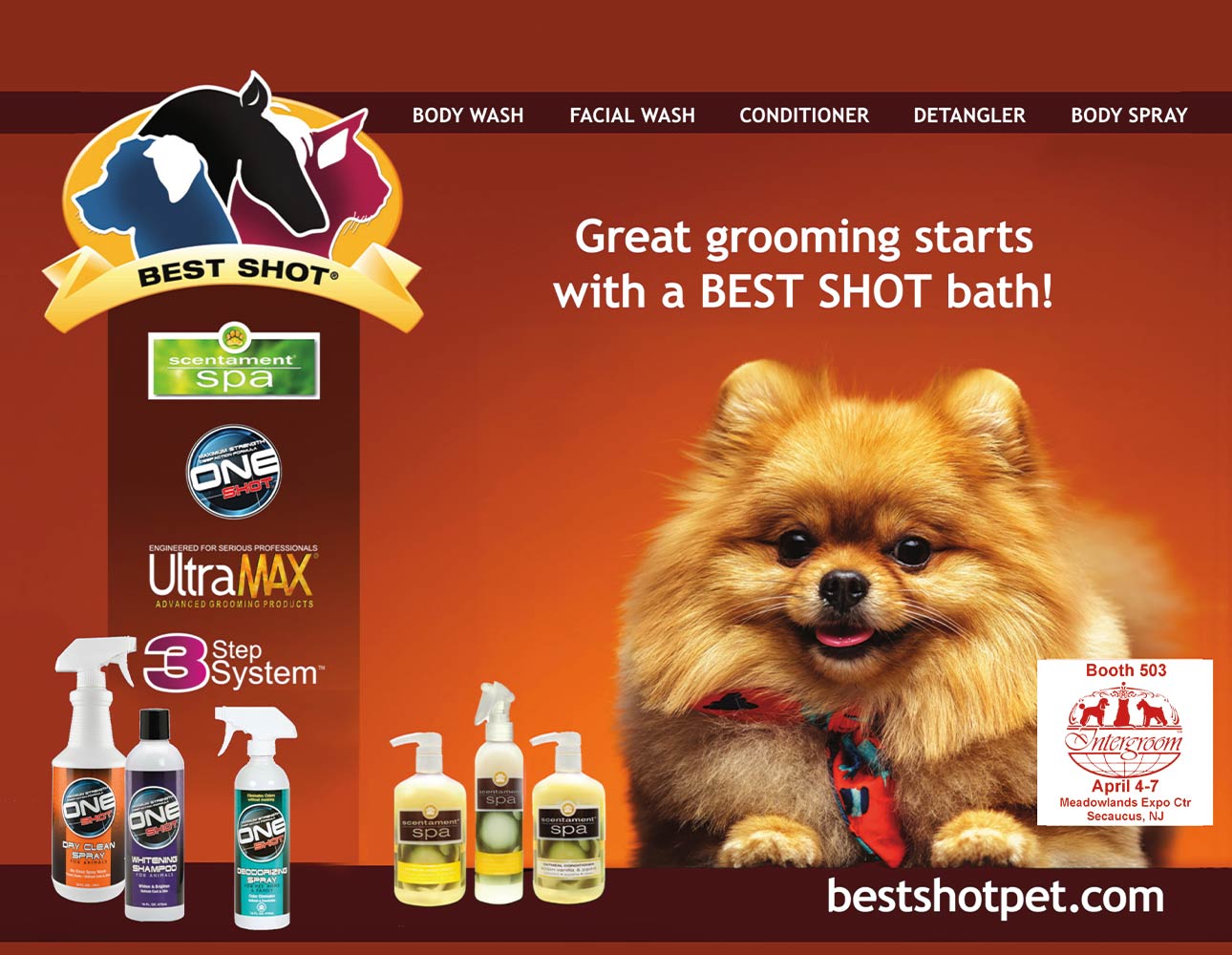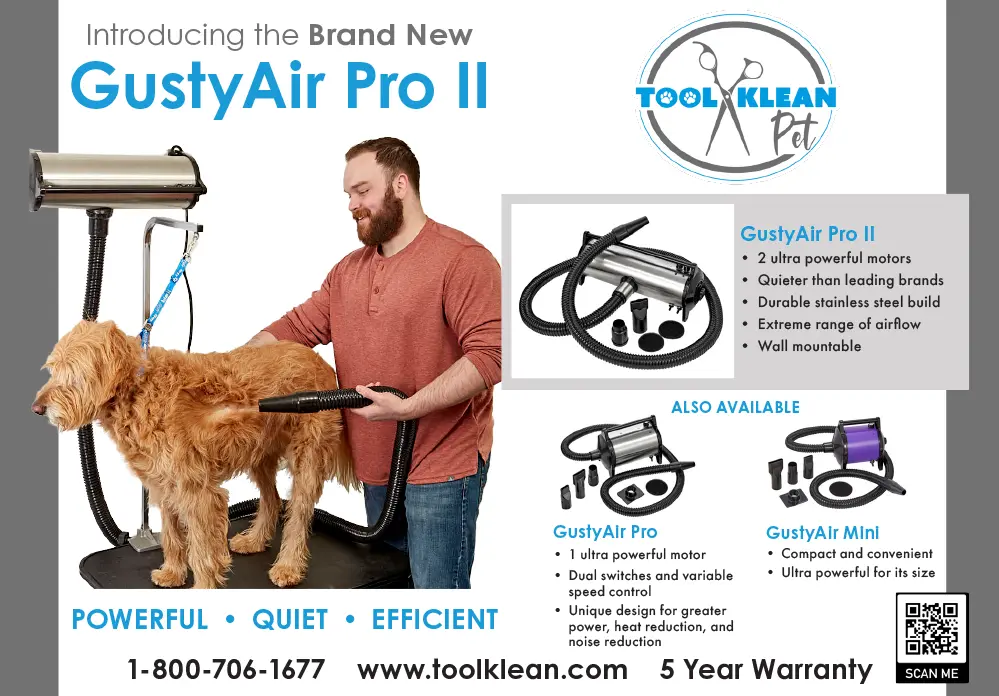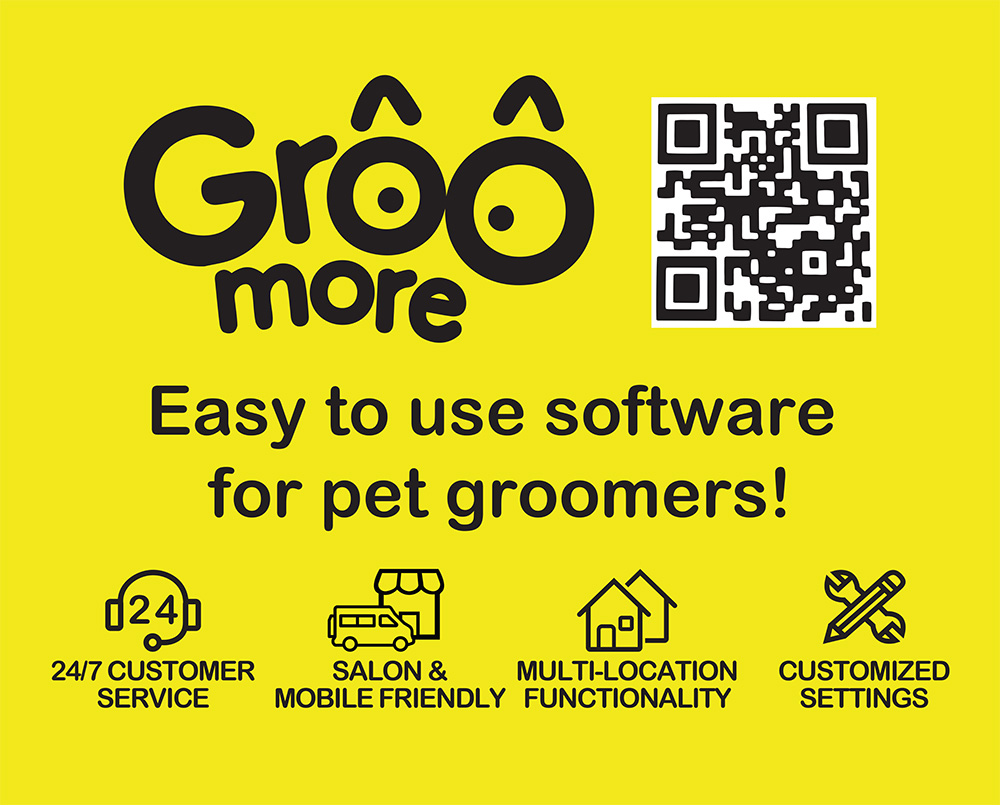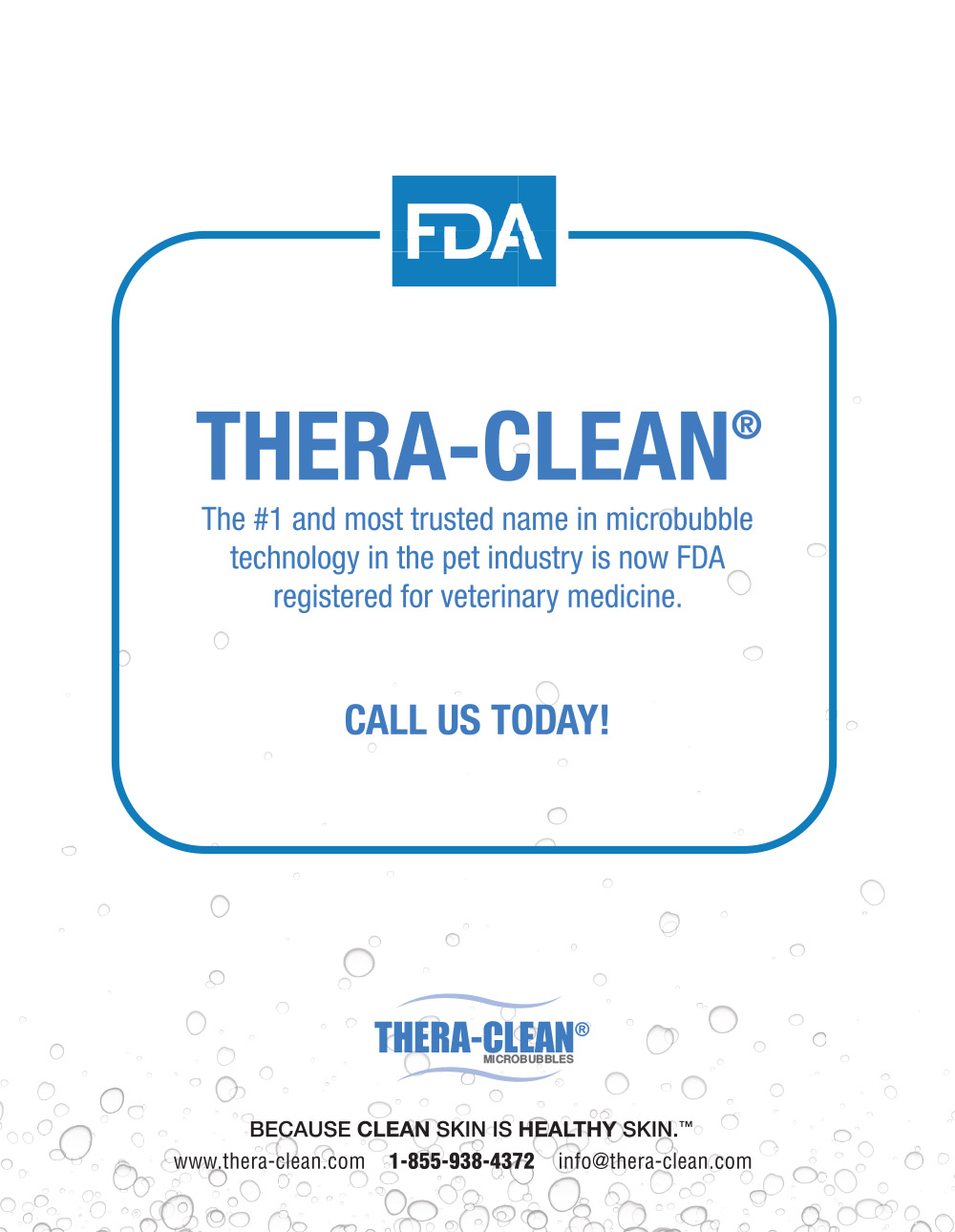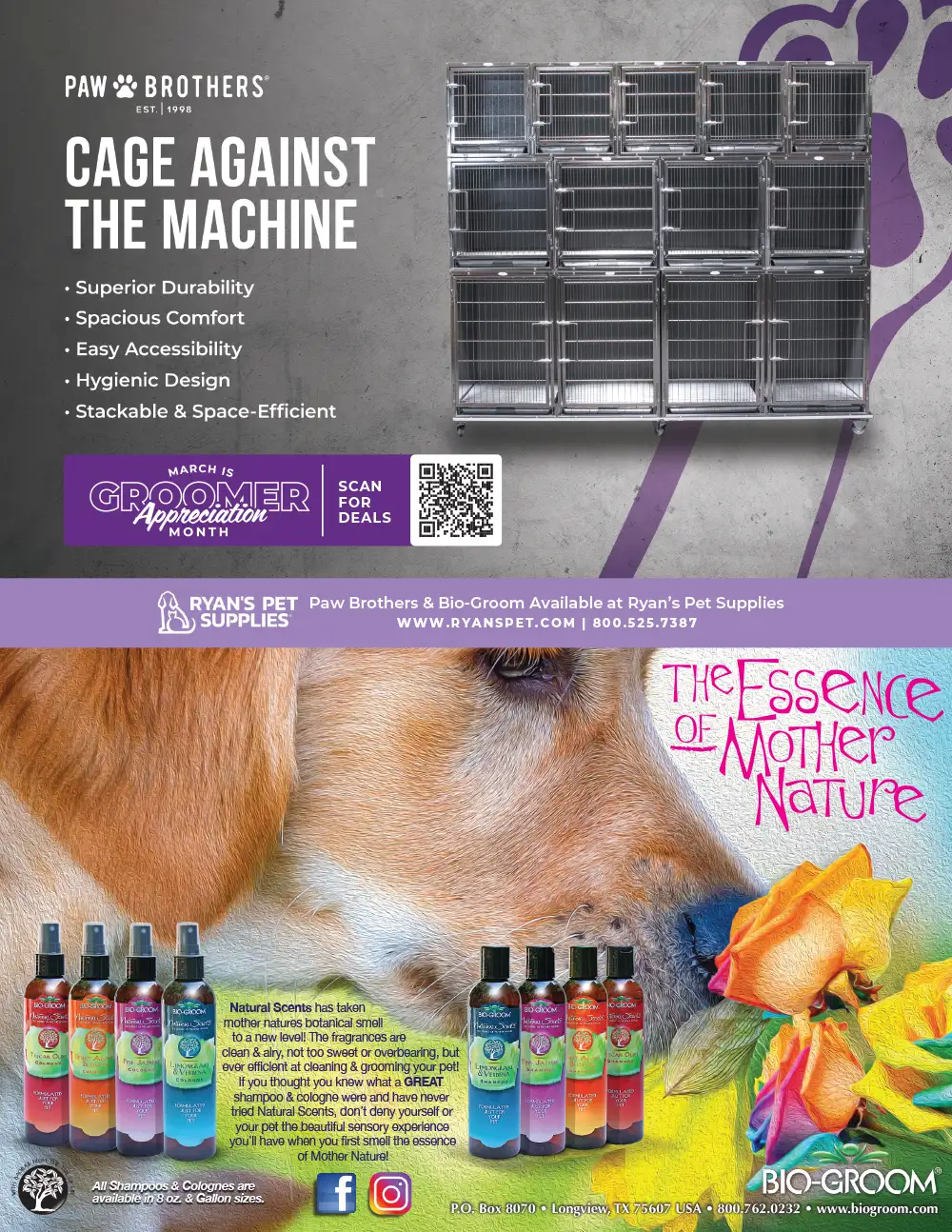Contents | March 2024
28
by Louise Dunn
44
by Blake Hernandez
ALSO INSIDE
todd@barkleigh.com
adam@barkleigh.com
gwen@barkleigh.com
rebecca@barkleigh.com
luke@barkleigh.com
laura@barkleigh.com
brandi@barkleigh.com
carlee@barkleigh.com
evan@barkleigh.com
cassidy@barkleigh.com
allison@barkleigh.com
james@barkleigh.com
karin@barkleigh.com
britany@barkleigh.com
Daryl Conner
Jonathan David
Dr. Cliff Faver
Blake Hernandez
ALSO INSIDE
ON THE COVER
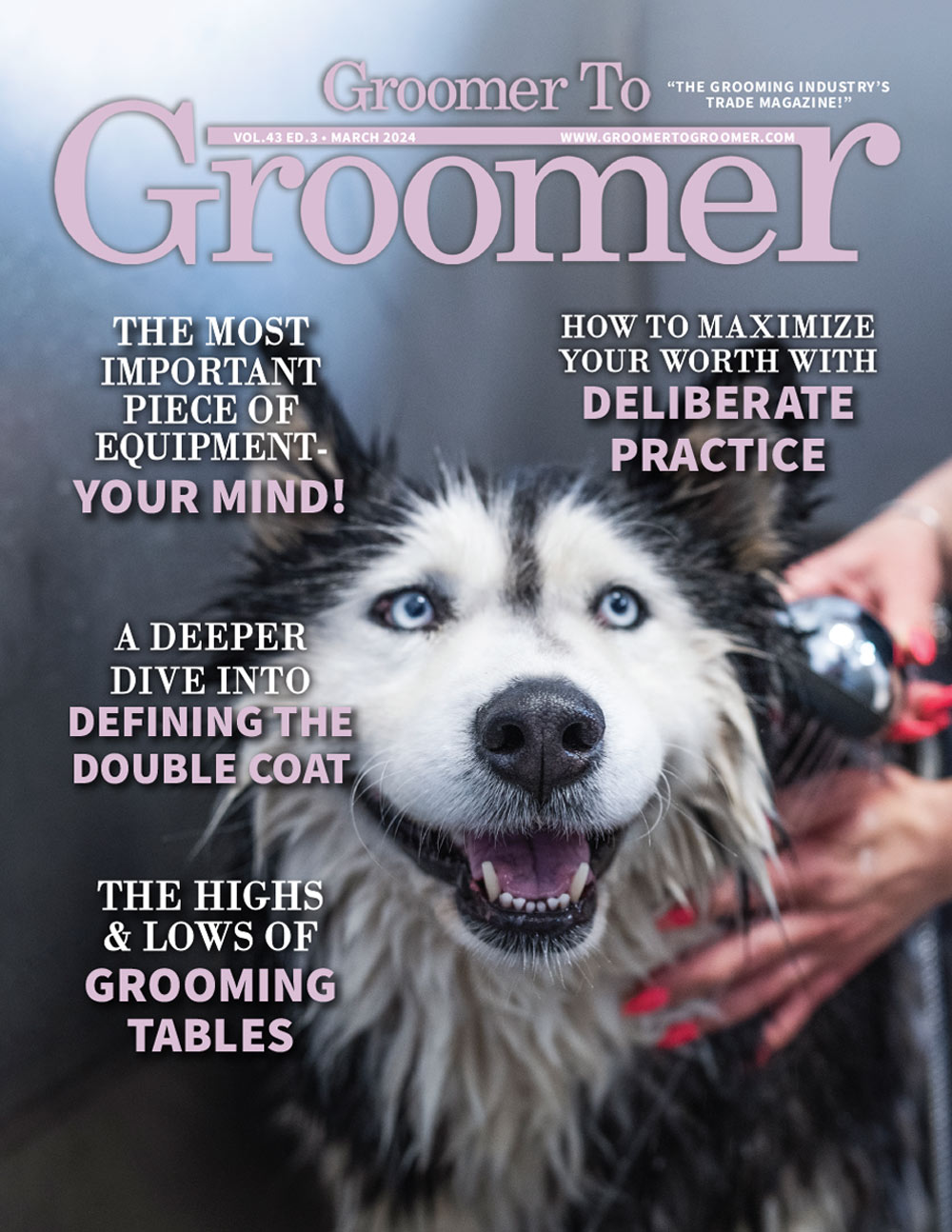
it’s advertisers for their continued support.
- Andis2
- Animal Photography50
- Artero17
- Bandanas Unlimited42
- Best Shot Pet39
- BioOx54
- Cool Dog Wash Tubs18
- Cosmos Bathing System52
- Direct Animal Products19
- Double K Industries3
- Electric Cleaner Company23
- Envirogroom | Special FX47
- Evolution Shears7
- Governor Insurance Agency25
- Groom Team USA38
- Groomer’s Best32
- Groomer’s Choice4
- Groomers Mart26
- Groomore49
- IV San Bernard | Pet Skin Academy15
- Jodi Murphy30
- Laube55
- Metrovac9
- Paragon37
- Pet Boarding Expo West27
- Pet Business Insurance8
- PetLift43
- Puppy Play Ground35
- Quadruped Pet Care33
- Ryan’s Pet SuppliesDigital Only
- Ryan’s Pet Supplies56
- Showseason Tent Sale29
- Stazko31
- The Absorber Dog Lover’s Towel12
- Thera-Clean51
- Tool Klean14
- Tool Klean41
- Wag’n Tails13



 s groomers, it is essential to have the right equipment to function. We try to get the best quality for the best price, and then we have to do maintenance on it or replace it when it wears out. But have you ever sat down to determine which piece of equipment makes you the most money? Probably not, because with being a busy groomer, it is often hard to find the time to do that. So, to save some time, I will cut to the chase. The most important piece of equipment you have in the grooming salon is your mind.
s groomers, it is essential to have the right equipment to function. We try to get the best quality for the best price, and then we have to do maintenance on it or replace it when it wears out. But have you ever sat down to determine which piece of equipment makes you the most money? Probably not, because with being a busy groomer, it is often hard to find the time to do that. So, to save some time, I will cut to the chase. The most important piece of equipment you have in the grooming salon is your mind.

John Maxwell, a well-known business/motivational writer, says you should take time daily to be bored. At first, I had a hard time with the concept. But I found that if I take time to do nothing, I get my most creative thoughts. I found I could make more money sitting in my office being creative and strategizing than working hard in the exam rooms. Why is that? It is because I thought about ways to work smarter, not harder. If you are always working, you don’t have time to think about new or different ways of approaching problems.

From there, you start taking those big items and working them down into your day-to-day strategy. For example, I need to work with an accountant to help me figure out my prices. I need to talk to a broker so I know how to prepare for a sale (years in advance). I need to figure out what to do when my body no longer lets me groom a 140-lb. Great Pyrenees. Let’s organize a training program (or utilize some already available online) for the staff. Let’s work to fill our slow times of the year with specials. Let’s get more education and offer services that we don’t already offer. The sky is the limit. The secret is that you need to take time to brainstorm and think through all the possibilities.


Sometimes we think we have to do this all on our own, but the reality is, some of the best ideas are those from others. You may take those ideas at face value or morph them into your own with a twist on the original idea. Some of my best pearls of business practices I picked up sitting around with a cold drink and talking with friends.

Before you force people (clients or staff) to get involved, think about what would motivate you if you were in their position. Strong-arming or being a dictator may get you there, but if the people involved are unhappy about the process, this can turn a positive strategy into a very negative experience. And if it goes bad, often, as an individual, you are afraid to stick your neck out the next time. You only fail when you fail to plan. As a general rule, people don’t like change, so as a good leader in the business, you have to work on making these changes as painless as possible.
The very last step is to keep everyone accountable in the process of change. This step is critical if any change is going to occur long term. They say it takes 21 days to change a habit (I find it closer to three months), but the change will not survive without this step.
Your thoughts and creativity that occur in your mind make it your best piece of equipment; take time to use it, trust it and hone it. When you start using it, you will find life is easier, making you far more money than any other piece of equipment in your shop.
Dr. Cliff Faver graduated with a BS in Biology/BA in Chemistry before getting a Veterinary degree in 1987. He is the past owner of Animal Health Services in Cave Creek, Arizona and now the US distributor for Iv San Bernard products, teaches the ISB Pet Aesthetician Certification program, and speaks internationally on hair and skin. His passion is to merge groomers and veterinarians to aid in helping and healing pets. He is also a member of AVMA, AAHA, AZVMA, Board member with Burbank Kennel Club, and has served on Novartis Lead Committee, Hill’s International Global Veterinary Board, and a Veterinary Management Group.
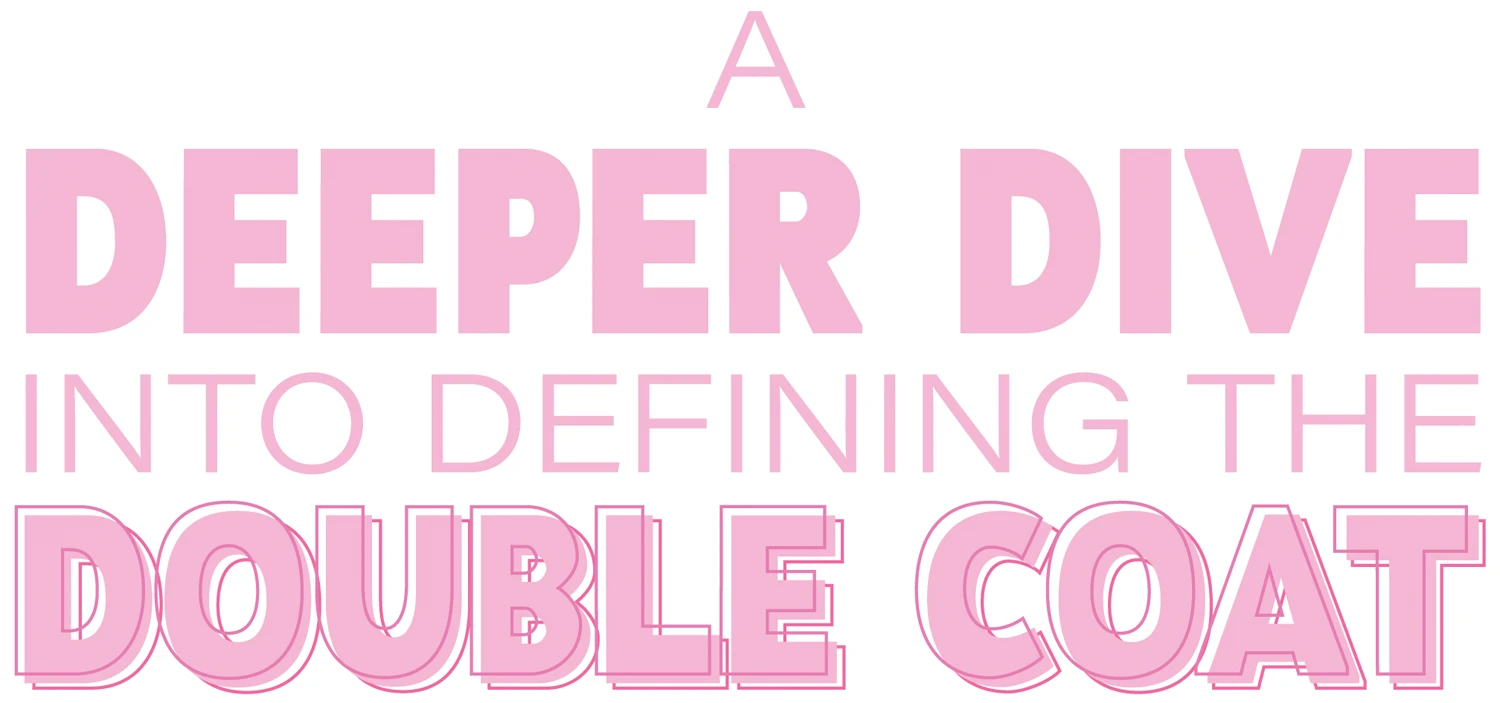
by Jennifer Bishop Jenkins

 here are an estimated 900 million dogs in the world and most are double coated. Approximately 80%1 live without a home or owners and are called free ranging.2 They are all short- or medium-length double coats, and a large number of pet dogs are also double coated. All their fellow canids in the wild, such as foxes, coyotes and wolves, have a medium-length double coat, which is called the “natural” or “normal” category of canine coats by veterinary dermatology texts.3
here are an estimated 900 million dogs in the world and most are double coated. Approximately 80%1 live without a home or owners and are called free ranging.2 They are all short- or medium-length double coats, and a large number of pet dogs are also double coated. All their fellow canids in the wild, such as foxes, coyotes and wolves, have a medium-length double coat, which is called the “natural” or “normal” category of canine coats by veterinary dermatology texts.3
Had humans not spent millennia selectively changing dogs’ coats to serve other purposes, this would likely be the only coat type for dogs—but it is not. We have everything from Poodles to Bergamascos to Maltese to the American Hairless Terrier now.
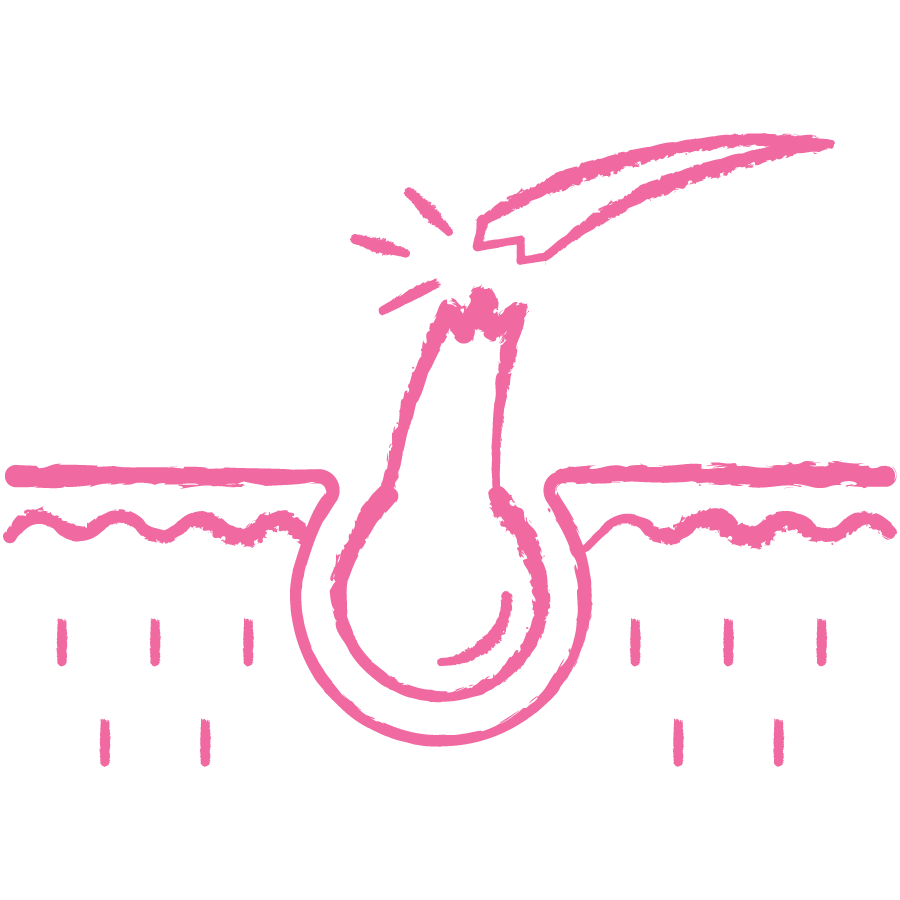
A Language Problem
So why is defining this basic term “double coat” even an issue for us? To precisely define what the double coat is and how it works should be important to our industry, given its universality. Yet, this most common of all dog coats illustrates a language problem we struggle with, because the term “double coat,” like some other key vocabulary words for us, is not always used by groomers to refer to the same thing.
Our pet grooming industry is not only largely unregulated, but certification through extensive hands-on testing under the direction of a master (mandatory in other trade industries), is entirely voluntary for us. Our industry has, as a result, not yet acquired the standardization of curriculum and practice that other trades have. Such standardization leads to the creation of jargon—a mutually agreed upon common vocabulary of specialized terms used to speak about technical specifics, like the words that doctors and lawyers use when they speak to each other.
Sadly, it is the dogs that sometimes pay the price for this lack of agreement on basic concepts in dog grooming. However, the more we all work to educate ourselves by attending trade shows and online events, by reading researched publications and by talking with each other about this, the more we help to build that common understanding of words we all use.
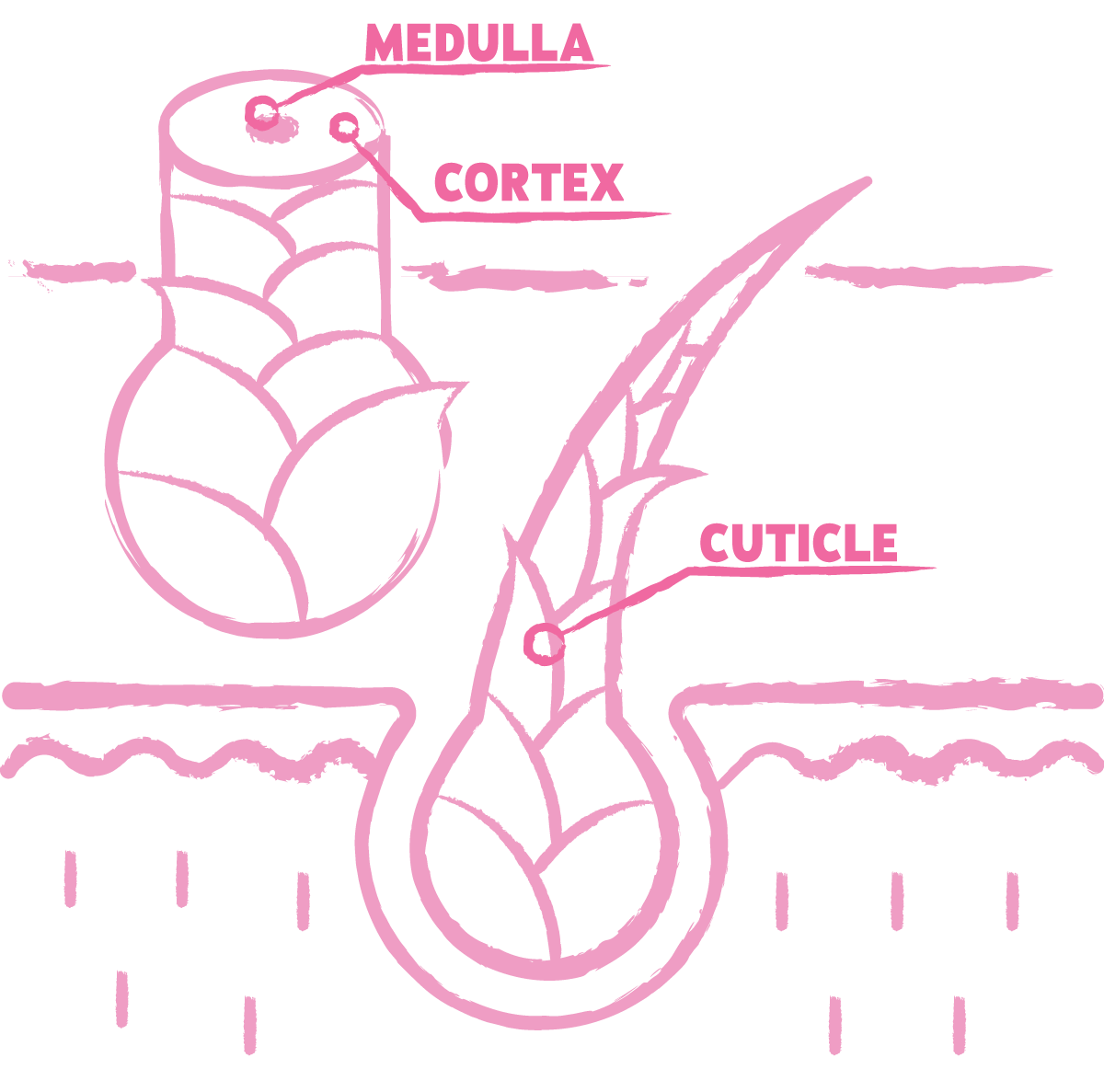
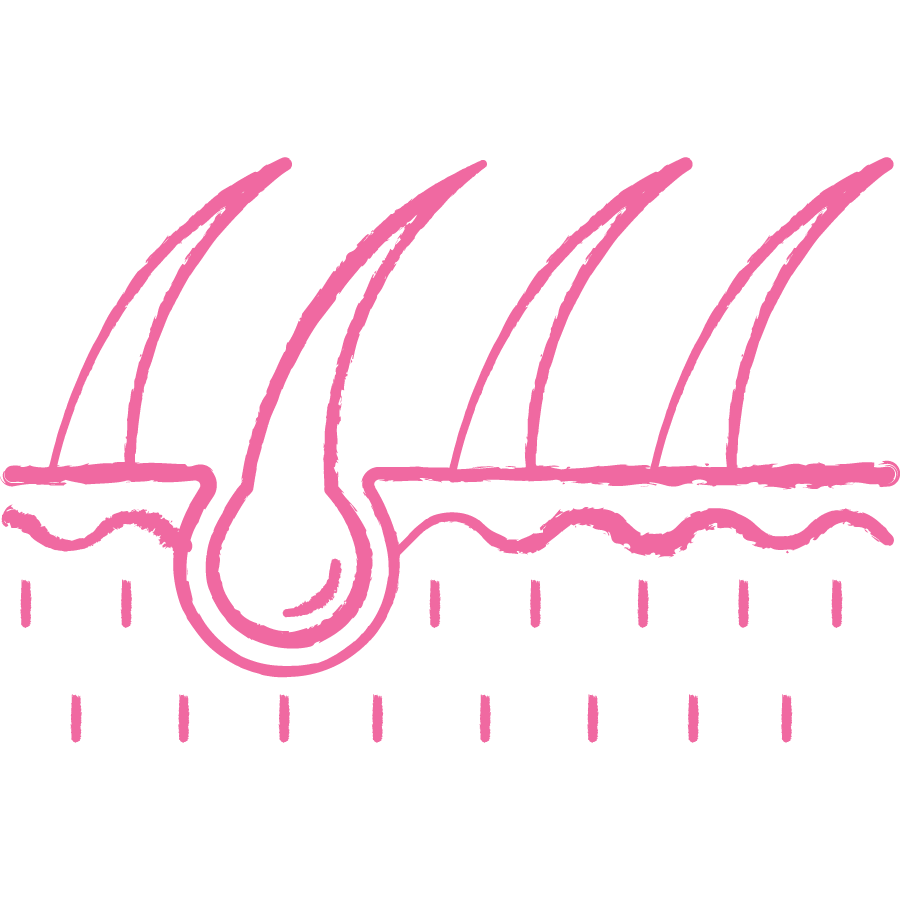
Primary vs Secondary Hairs
The most common misunderstanding that I hear is that double coats apply to any coat type that has both primary and secondary hairs. These different hairs are also called topcoat, or guard hairs, and undercoat.
Mammals all have hairs of various kinds that are governed by genetics. Like our skin, hairs are made up of keratin proteins and are filament-like extensions of the skin composed of mostly dead cells. In mammals, all hairs and their follicles can have different shapes, pigments, lengths, sizes and textures.
Anatomically, primary hairs have three layers. The scaly, outer protective part of the hair is the cuticle. The strong, stretchy, inner core of the hair is the medulla. And in between those two lies the middle layer of the hair, the cortex, which contains, among other things, hydration, pigment and nutrients. Primary hairs have all three of those layers. They are always longer, taller, more substantive, more weather resistant and more pigmented than secondary hairs, as well as longer lasting, often for years.
Secondary hairs lack a medulla. They are not fully formed hairs. They are temperature-regulating fuzz—a form of insulation that increases during the colder, shorter days, and falls out quickly when the days grow longer and warm up. They change their entire thickness twice a year prior to the solstices. They are always fuzzy, come in and fall out very quickly, and are not weather resistant or protective of the skin.
On a true double coat, the primary and secondary hairs are on an entirely different schedule and agenda and do not require much human interference. The primary hairs have a slow-growing or anagen growth phase, and a long dormancy in the telogen or resting phase, often for years. They come in and are meant to stay in order to provide structure and protection of dogs’ skin. The secondary hairs go from anagen to catagen to telogen and out very rapidly, several times a year. Their job is to regulate temperature.
This is why fur-type dogs can’t be cut or shaved. Only de-shedding should be done to assist in removing the undercoat as it sheds out naturally. If you shave a double coat a few times in their lives, they will likely never grow back their primary hairs, leaving only the undercoat to grow back. Skin cancer, among other things, is a danger if the primary hairs are removed. Our job as professional groomers is to remove seasonally shedding undercoat and protect the topcoat for its long-term job of skin protection.

A CLOSER LOOK
While it is understandable that some would feel the term “double coat” could apply to any dog’s coat that has both primary and secondary hairs, it is not a very helpful term for us to use simply because almost all dogs have primary and secondary hairs. So, if that were the definition of a double coat, we could not distinguish between the coats of a Labrador Retriever, a Shih Tzu, a Poodle and a Border Collie. Virtually every coat type except smooth coats like Boxers, Dobermans, and hairless breeds have both primary and secondary hairs. The double coat is more than just the presence of those two types of hairs.
Double-coated breeds have primary and secondary hairs, as most dog coats do, but what is unique to the double coat is the natural seasonal shedding cycle of a massive amount of undercoat. This is aligned to the seasons and triggered by the change in the length of light as winter and summer solstices approach.
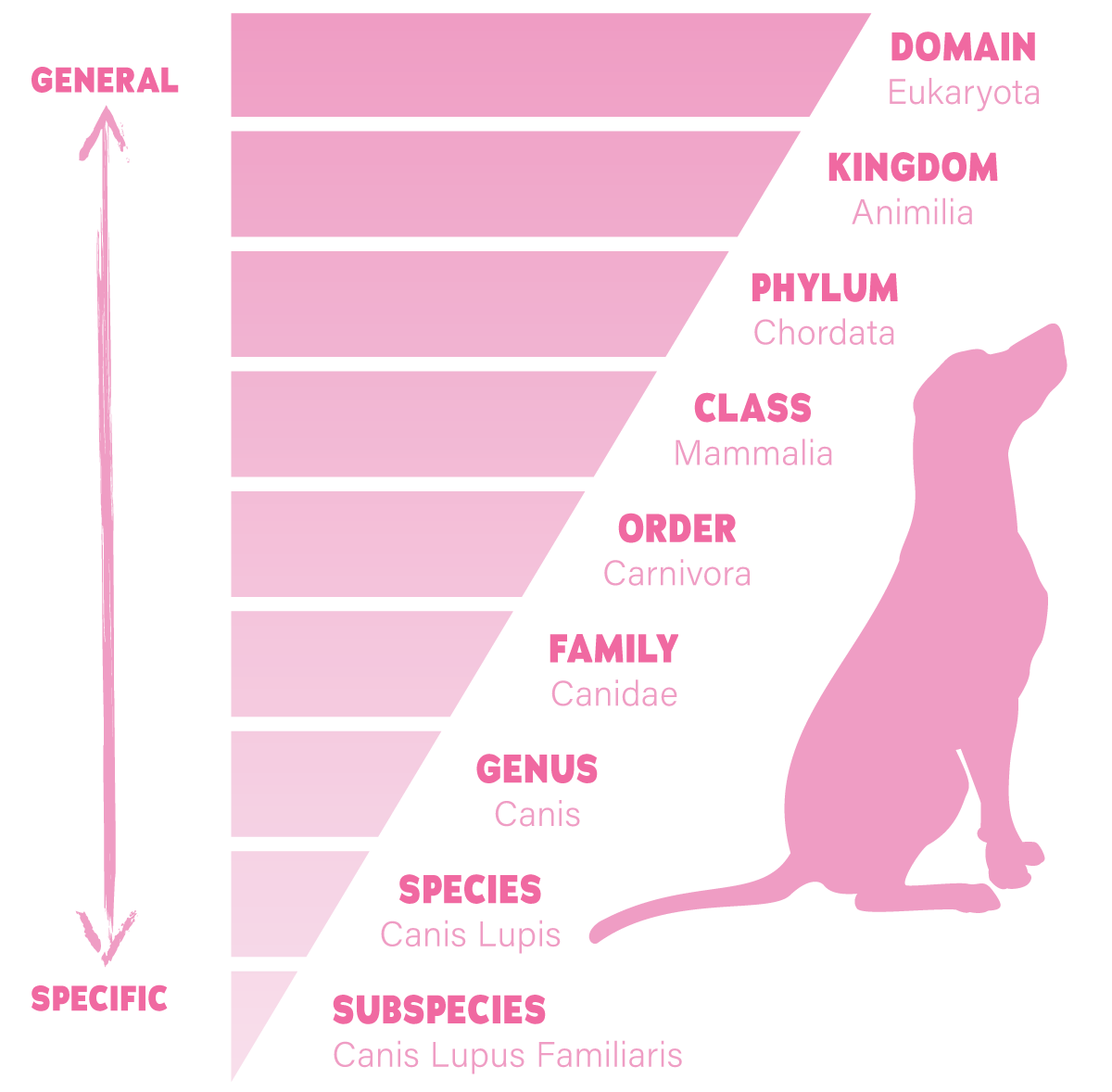
On wolves in the wild we can observe tufts of undercoat blowing out on their own in the spring, making way for a summer coat that allows airflow to the skin while still reflecting dangerous sunlight away. This natural double coat largely cares for itself and works well without professional grooming. Of course, if you are living with an Australian Shepherd, a Newfoundland or a Samoyed—all true double coats of different lengths—professional grooming helps keep your home much cleaner.
Wire-coated breeds like many terriers do not seasonally blow out their secondary hairs the same way. Their coats require some pulling to help their shedding cycles because of their thicker skin, deeper follicles and more complex wire-textured protective hairs. The secondary hairs of Poodles and Shih Tzus may appear on our combs as we pull through their coats, but they do not shed out seasonally like a true double-coated dog would. In fact, in most hair-type, undetermined-length coats, the secondary hairs are almost as long as the primary hairs.
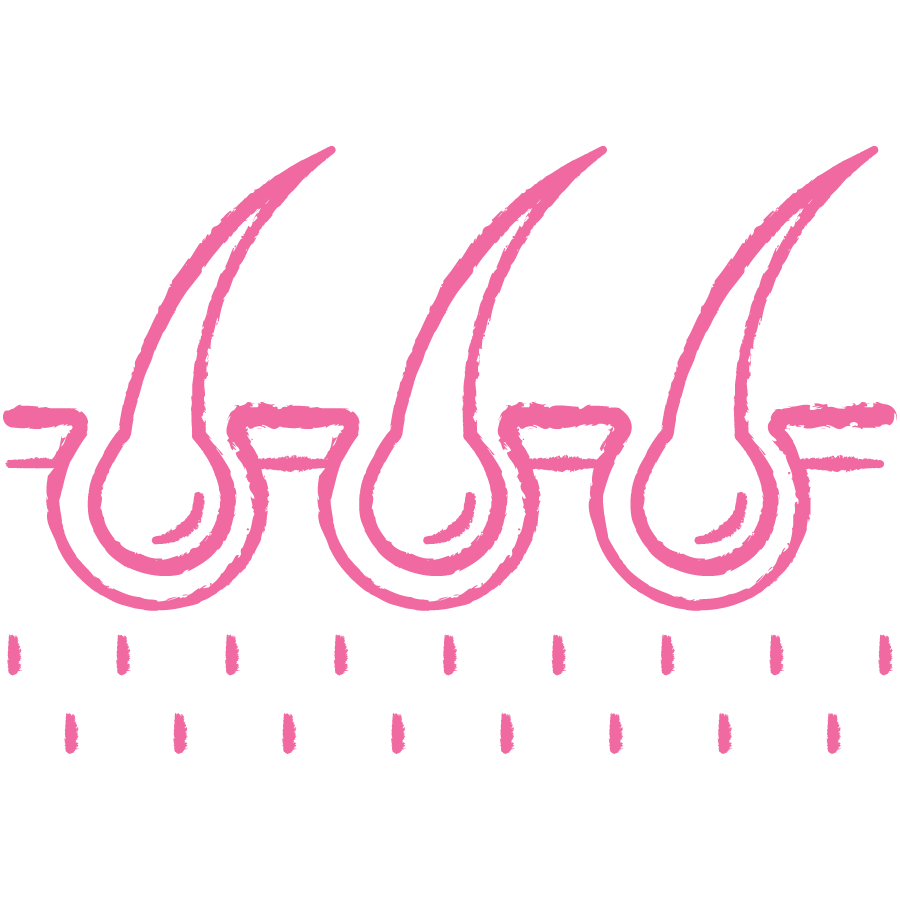
Defined in Biology
The best and most basic definition of anything biological is to look at that organism’s taxonomy, a term you may have heard in high school biology. Taxonomy is a scientific naming convention that systematically classifies all living organisms, from microbes to plants and animals.
Taxonomically, dogs are a multi-celled organism—clearly an animal, not a plant. Their phylum is Chordata, which means they are vertebrates. Their class is Mammalia, which means they have skin and hair, and are warm-blooded and nurse their young, like us Homo sapiens. The order level is where we split from them; they are carnivores and we are primates. Their family is Canidae, commonly referred to as canids. This includes foxes, coyotes, wolves, jackals, dingoes, dogs, etc. Their genus, species and variety is Canis lupus familiarus (meaning domesticated dog).
The most important way we groomers can define the double coat is to ground it in that scientific understanding of its biological makeup. The double coat is the natural coat of the entire Canidae family. The double coat is, by definition, what most canids have all over their bodies.
One reason why the dog is so diverse in appearance is because they have co-evolved with us for tens of thousands of years—the only two species on Earth known to co-evolve in this relational way. We humans live in diverse climates, hunting for diverse food sources, all over the planet. The most diverse single mammal species is the dog, developed both naturally and with some human help, over tens of thousands of years to be built for those specific places and those specific jobs.
While still very present, not just in the wild but in our homes, the many domesticated true double-coated breeds that are our beloved pets—from Labrador Retrievers and German Shepherds to the longer double coats of Shelties and Newfoundlands—we groomers still have a job to do for them. We can help remove the shedding secondary hairs for their weary families while protecting the vital primary hairs to keep their natural coats functioning throughout the year. And, since we already know when these coats will need the most care, we can schedule accordingly and be ready for them when shedding season arrives!
References:
- Lord, K., Feinstein, M., Smith, B., Coppinger, R. (2013). Variation in reproductive traits of members of the genus Canis with special attention to the domestic dog (Canis familiaris). Behavioural Processes. 92: 131–142.
- Gompper, M. (2013). The dog–human–wildlife interface: assessing the scope of the problem. Free-Ranging Dogs and Wildlife Conservation. Oxford University Press. pp. 9–54.
- Miller, W., Griffin, C., Campbell, K. Muller and Kirk’s Small Animal Dermatology, 7th Edition. Saunders.
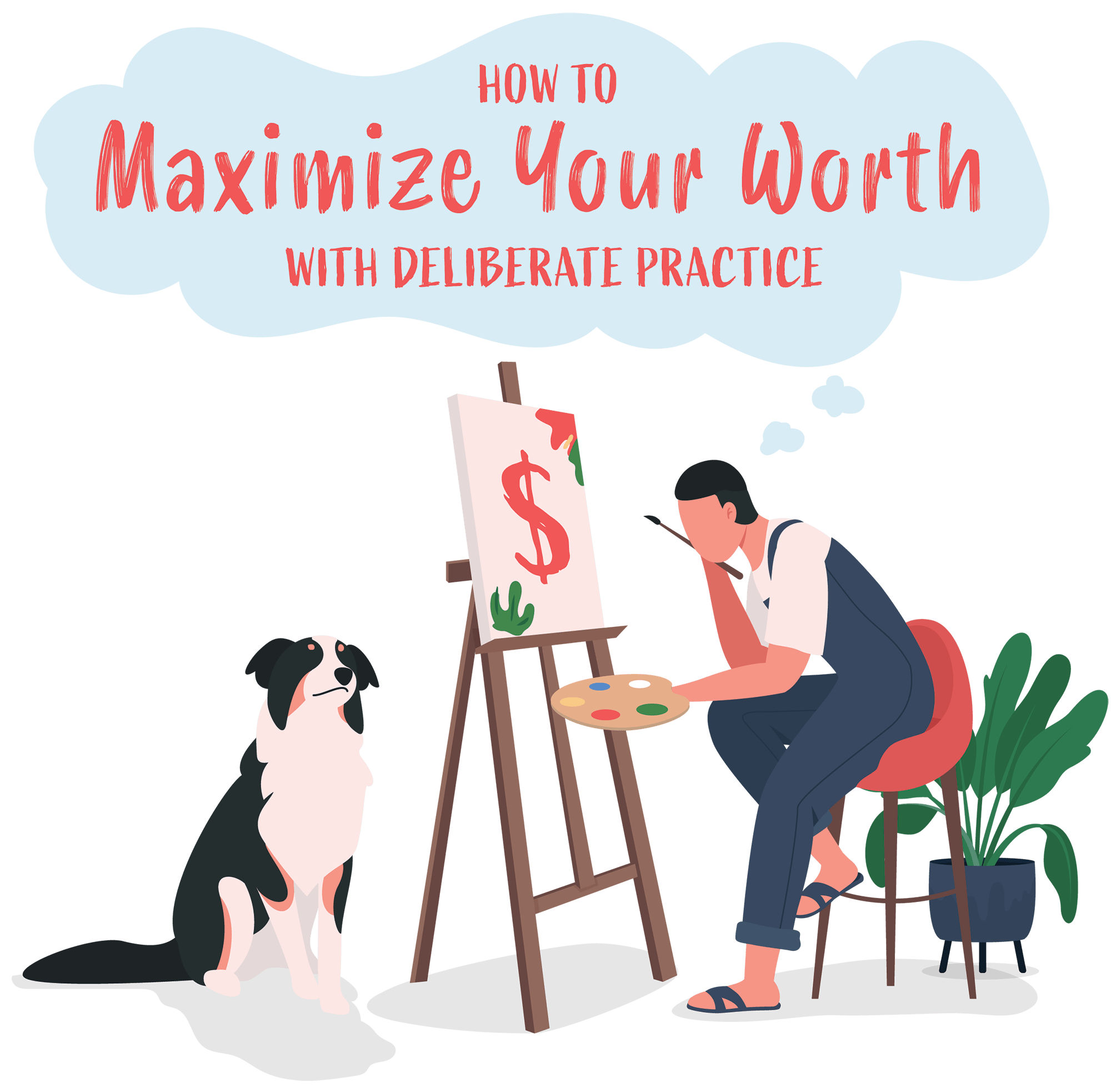
by Mary Oquendo
 ricing is one of the biggest challenges groomers face. How much should I charge? and What would you charge? are questions frequently posted in Facebook grooming groups. The fact that my time had value was a concept I had a hard time wrapping my head around. It countered how we, as an industry, were taught to think. It wasn’t until I nervously sat down with a client right after I opened my mobile grooming business in 2002 that the concept made sense.
ricing is one of the biggest challenges groomers face. How much should I charge? and What would you charge? are questions frequently posted in Facebook grooming groups. The fact that my time had value was a concept I had a hard time wrapping my head around. It countered how we, as an industry, were taught to think. It wasn’t until I nervously sat down with a client right after I opened my mobile grooming business in 2002 that the concept made sense.
The average shop price for a small dog was $35 at the time and took anywhere from an hour to an hour and 15 minutes to complete. When I went mobile, I knew I needed to charge more than the shops, so that meant a small dog was now anywhere between $50 and $65.
At the time, mobile grooming was unheard of, and several people called me and expressed sticker shock. But it was a client that set me straight. I was sitting in the kitchen of a client that followed me from the shop. Her price went up $30, and based on the average price in the area, I was almost double for most breeds.
I felt comfortable enough with this client to ask how she felt about my pricing. She looked at me and said that I just gave her back two hours of her day. That’s the time she spent driving back and forth to the shop where I worked. She said she used those two hours to work on a book she was writing. And with her writing time being limited, those two hours were worth the extra cost.
That was an eye-opener for me. My time has value. But what exactly was my value? How do I determine what my worth is? Well, it involves knowing your numbers…
Say I want to earn $100,000 for the year, and my business expenses are $50,000. (Understand that these are random numbers based on ease of math. For this to work, you have to know what your living expenses are and what it takes to run your business.) So, the total income I need is $150,000 to clear that $100,000. I plan to work 50 weeks of the year (don’t forget vacation time) for approximately 40 hours per week.
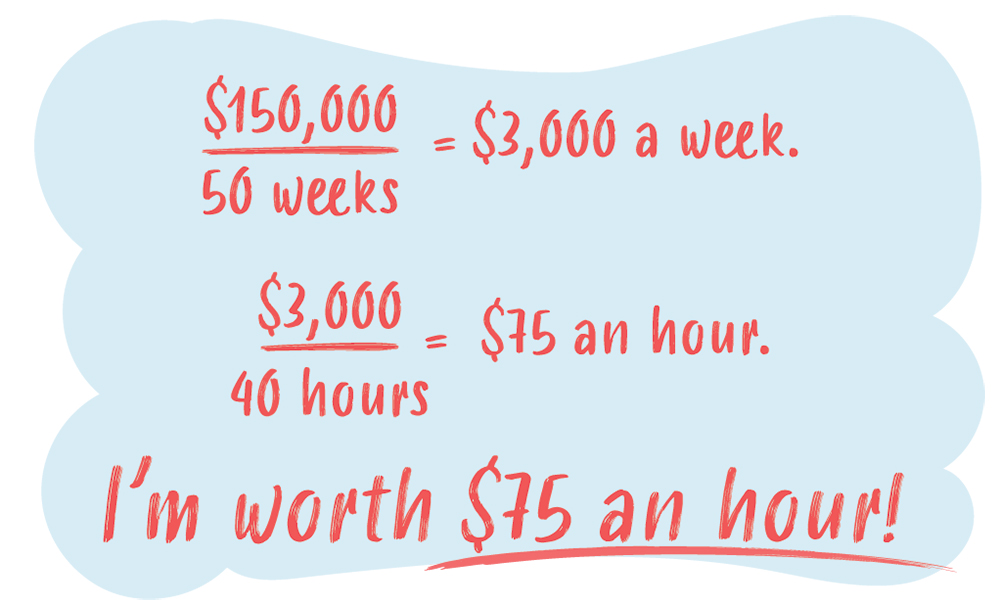
Another option is hiring, whether it’s grooming employees (paying employees is a whole other article) or outside service providers such as cleaning companies to work at a lower hourly rate than your value.
Now I want to introduce another principle called “Deliberate Practice.” I first heard this term in the book Badass: Making Users Awesome by Kathy Sierra. Deliberate Practice is when you work on one particular skill until you master it and then move forward. The intent is to make the most of the value assigned to your time.
Instead of being exceptional, you are “meh.” You’re spending too much time on a task while not being effective at what you’re doing. But what if you took the time to master each skill or hire out?
Statistics show that when Deliberate Practice is effective, it should take three sessions to master. If it is taking longer than three sessions, you need to re-evaluate. An example would be learning how to use QuickBooks and being responsible for the bookkeeping vs hiring a bookkeeper.
There are always jobs as a business owner that you are responsible for but dislike doing or don’t want to take the time to master. If that’s the case, don’t waste your time trying to master that skill. Hiring out is the only option.
When you know precisely what your time is worth, you can make better decisions that propel your business forward rather than just wasting time and not earning your true potential.
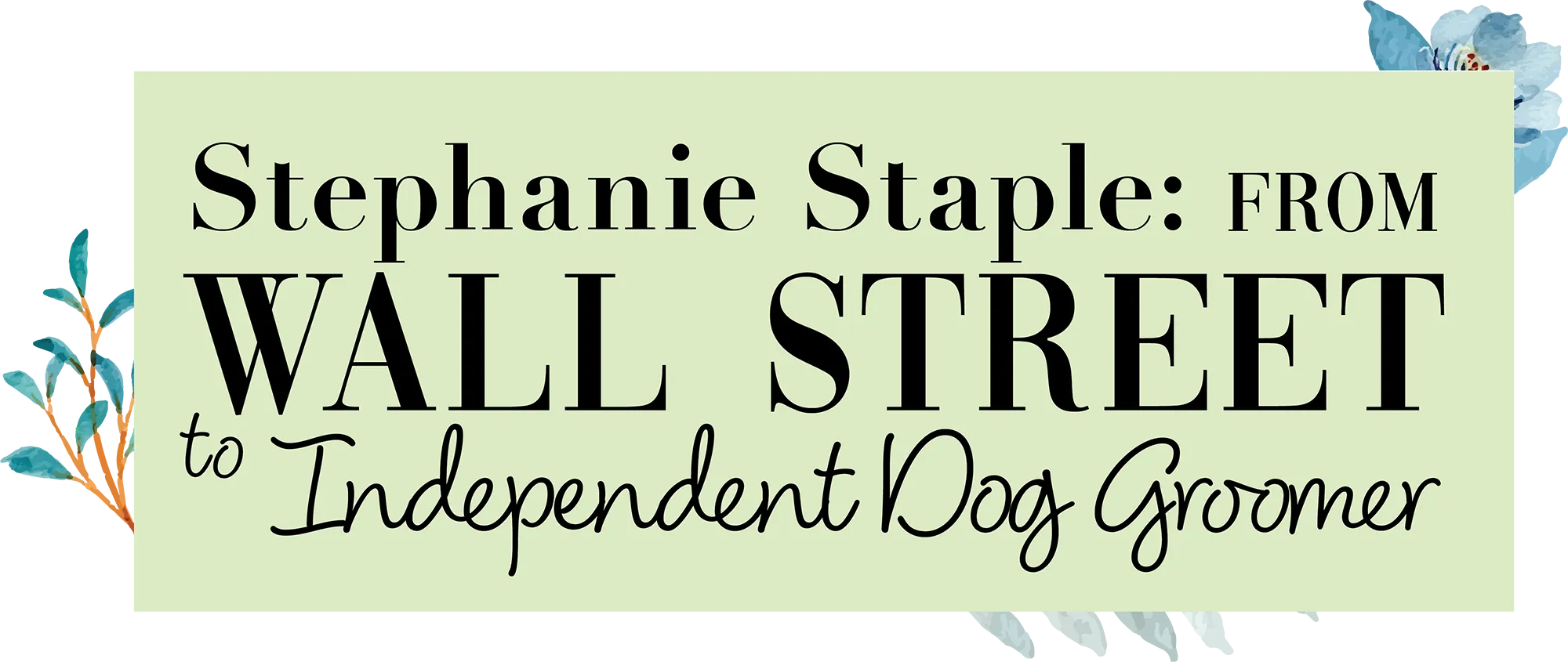

Photos provided by Stephanie Staple
 n 2009, Stephanie Staple started walking dogs as an excuse to get outside and add balance to her life. Little did she know, it would grow into a new career direction…
n 2009, Stephanie Staple started walking dogs as an excuse to get outside and add balance to her life. Little did she know, it would grow into a new career direction…
“After 20 years in Corporate America, deep down, I knew I needed a change,” shares Stephanie. “I used my degree in Business Management and Marketing on Wall Street. Though it was exciting and flattering, I wanted something different and to reinvent myself.”
To find that something different, Stephanie turned to her love of pets. “I started walking on the weekends for leisure, and the idea of walking dogs for a living was born,” she says. “I walked into a building in Brooklyn with 16 or 17 floors, thinking surely someone here had pets, and I offered dog walking services only on weekends since I still had my full-time job. My first call was for cat sitting.”


Word got around, and she quickly added dog walks, then dog boarding, and finally dog grooming. “I thought if I can walk them, I can board them, and ultimately groom them,” Stephanie recalls. “It was a home away from home for my clients’ pets, and exactly what my clients were looking for. People trusted me, and still do. I boarded dogs for about five years, but the demand became too much.”
During this time, Stephanie started taking night classes at a (no-longer-operational) dog grooming school in Manhattan. She currently works as an independent contractor at Paws in Paradise in Park Slope, Brooklyn and also offers in-home pet care for senior dogs.
“I have a handful of senior pets and senior clients, too, and they prefer to see their baby get groomed at home,” Stephanie shares. “They say grooming shops are noisy. It makes it easy on the owner because they don’t have to travel to a grooming salon. Most of them have a table, and all I do is take my tools, including the [arm] to secure the dog. I’ll recommend specific shampoos for their baby’s skin if needed.”
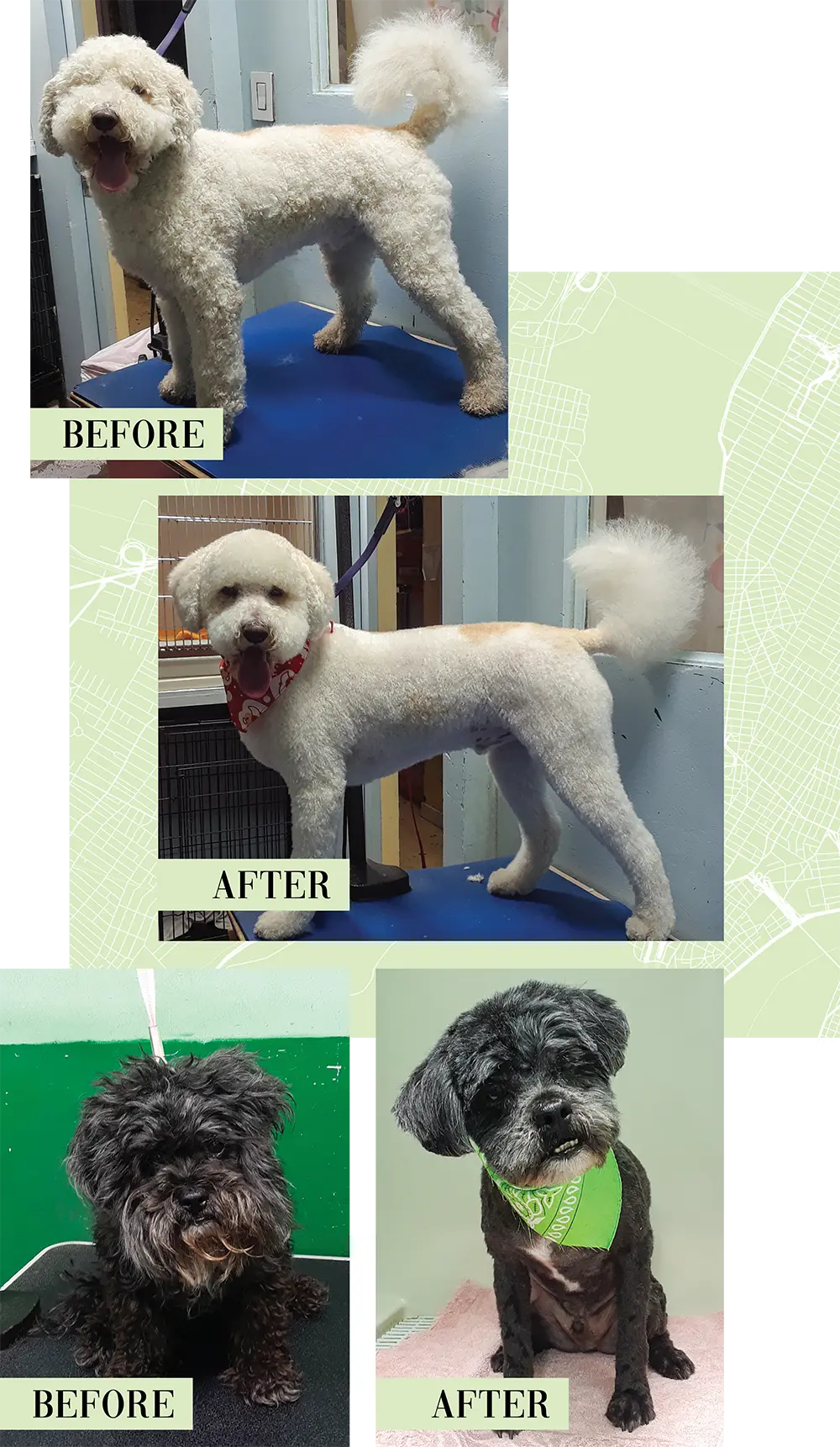

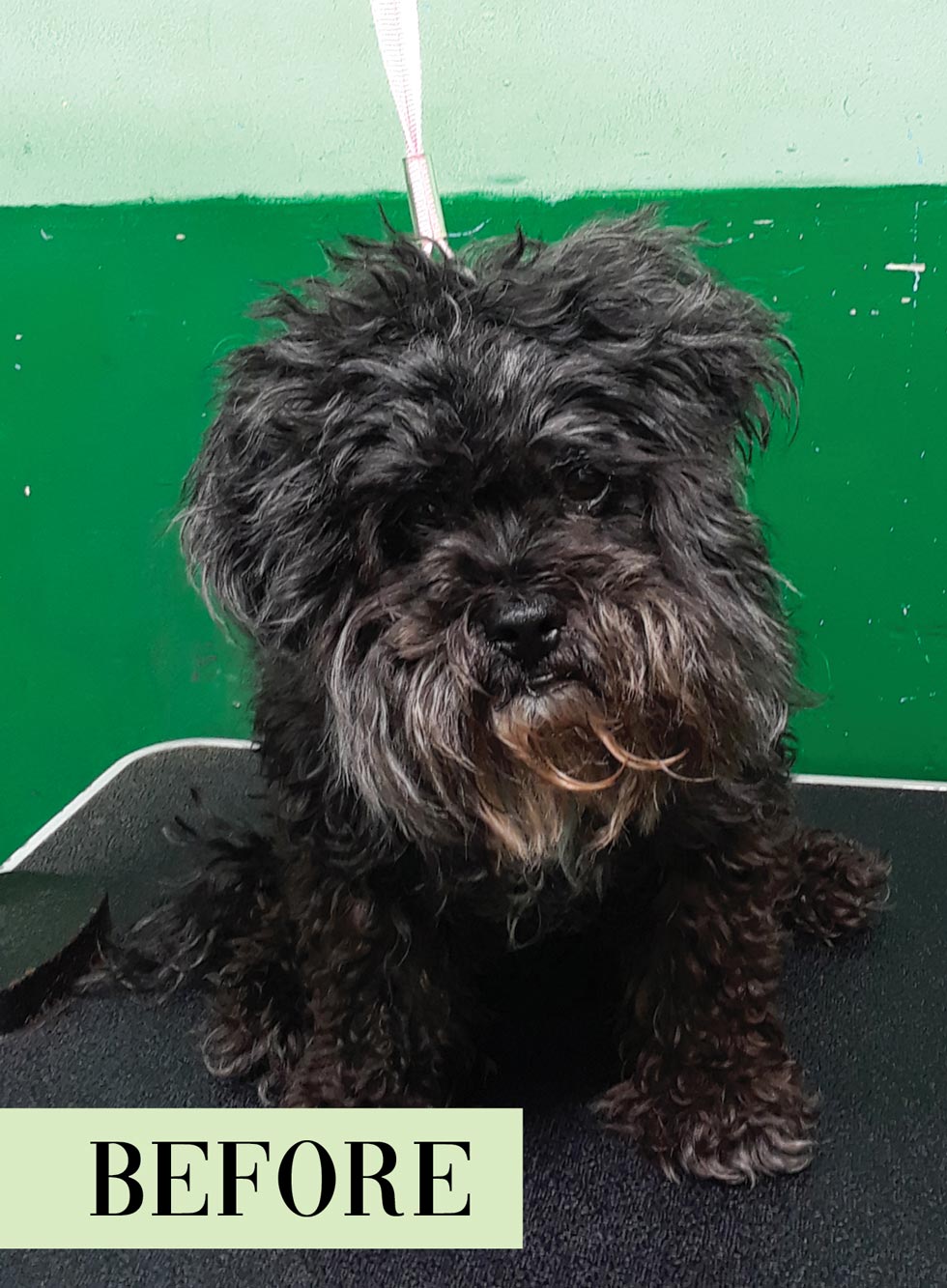
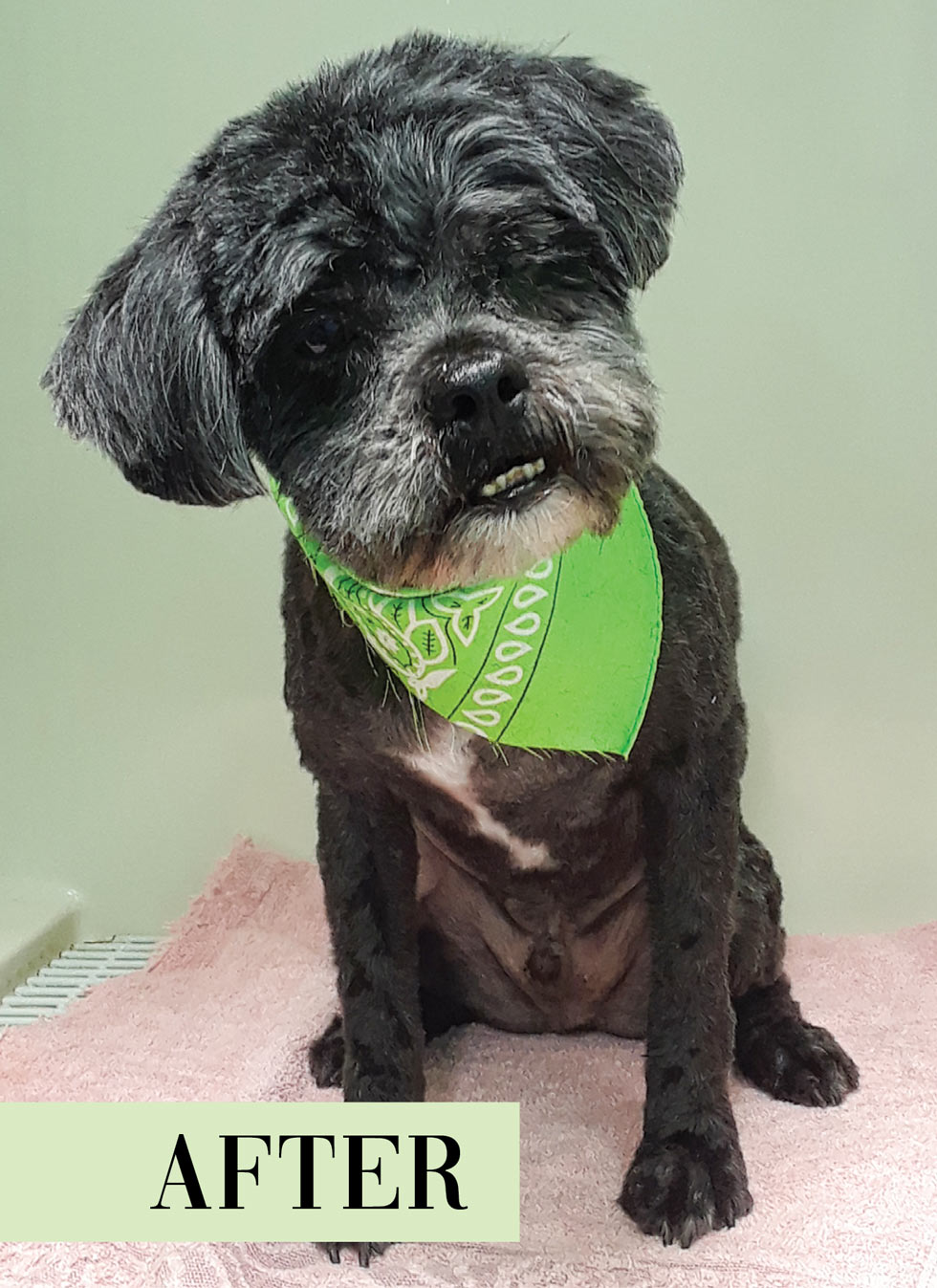
A Native of Panama Republic of Panama, Stephanie grew up visiting relatives across the United States. She attended Department of Defense schools in Panama, too, which means she’s grown up bi-lingual and bi-cultural. Both are an asset as a New York resident. Since she speaks fluent Spanish, she can work with many Spanish-speaking pet parents.

“Dog grooming entails not only the fancy, beautiful cut; it takes patience, determination, focus, prayers, and a special gift of love for dogs. It is considered to be a form of art that allows the dog to be your canvas.”
– Stephanie Staple
She says she offers two pieces of advice for new groomers:
“First, ask yourself, ‘Can I commit myself to dog grooming for the long term?’ Also, if you start like I did as a dog walker, keep in mind there are four seasons throughout the year. Are you willing to walk in the snow, rain, and extreme heat?


“Sometimes you’ll feel like you aren’t getting anywhere,” she adds. “But don’t give up. Feelings and emotions are normal. They come with the territory. Stick with it.”
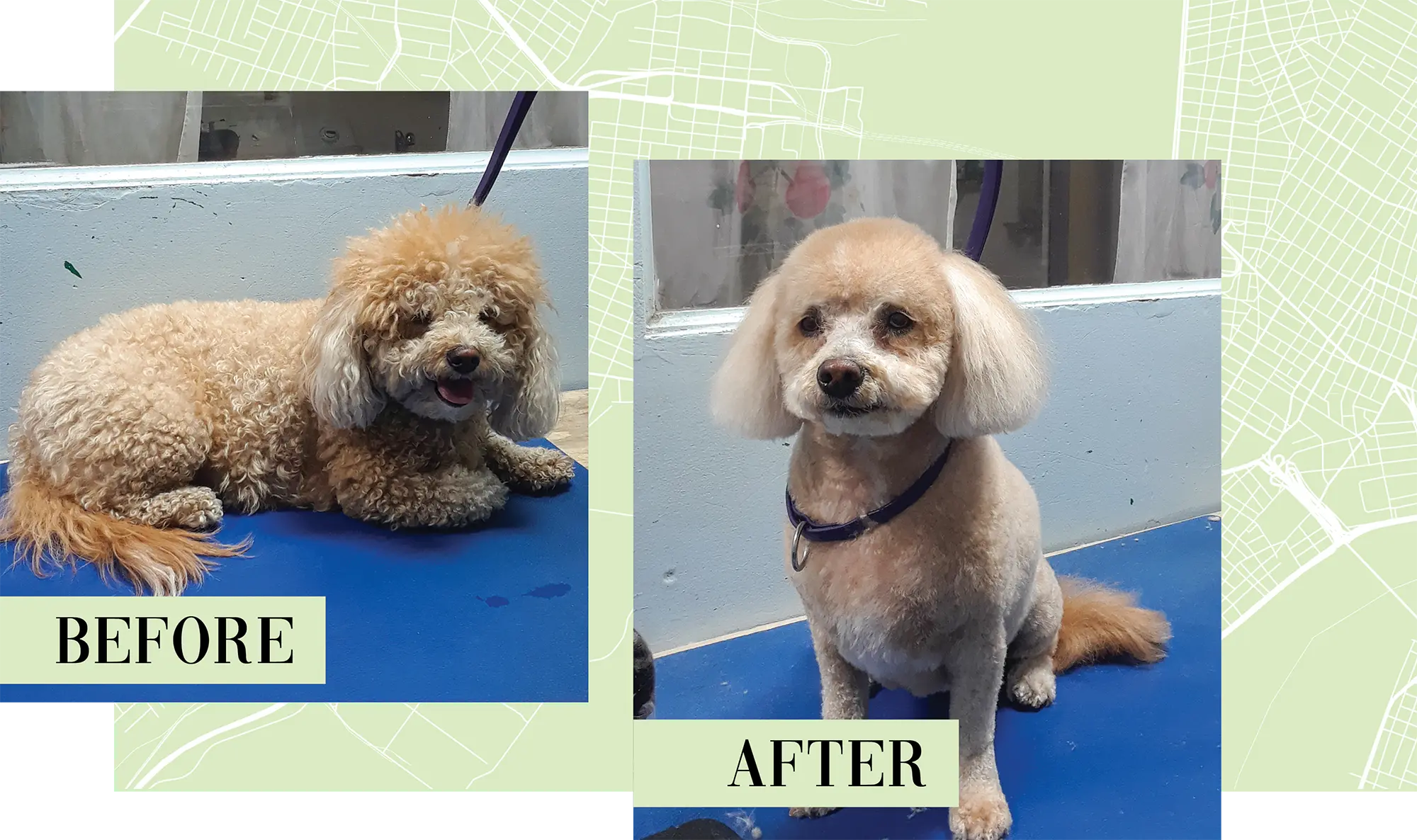
“There’s no reason to slow down. The reward is so valuable. Not just money-wise, but the trust.” – Stephanie Staple
“There’s no reason to slow down. The reward is so valuable. Not just money-wise, but the trust. It puts a smile on your face every day,” she concludes.

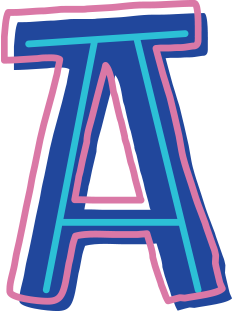 s a groomer of many years, I love what I do. But as we all know, pet grooming is a very physically demanding job, and by the end of a long day many of us are exhausted, often with an aching back, sore neck or painful wrists. What if you had something that would make your job easier and less taxing on your body?
s a groomer of many years, I love what I do. But as we all know, pet grooming is a very physically demanding job, and by the end of a long day many of us are exhausted, often with an aching back, sore neck or painful wrists. What if you had something that would make your job easier and less taxing on your body?
It doesn’t matter whether you are mobile, a salon or house-call, or if you are a new groomer or one that has been grooming for decades, the majority of your day is spent standing at a grooming table. Hour after hour, day after day, everything you do is centered around the table. But are you using a grooming table that is right for you?

 s a groomer of many years, I love what I do. But as we all know, pet grooming is a very physically demanding job, and by the end of a long day many of us are exhausted, often with an aching back, sore neck or painful wrists. What if you had something that would make your job easier and less taxing on your body?
s a groomer of many years, I love what I do. But as we all know, pet grooming is a very physically demanding job, and by the end of a long day many of us are exhausted, often with an aching back, sore neck or painful wrists. What if you had something that would make your job easier and less taxing on your body?
It doesn’t matter whether you are mobile, a salon or house-call, or if you are a new groomer or one that has been grooming for decades, the majority of your day is spent standing at a grooming table. Hour after hour, day after day, everything you do is centered around the table. But are you using a grooming table that is right for you?
Since groomers come in all heights and sizes, as do the dogs they work on, grooming tables that are adjustable to a range of varying heights offer tremendous benefits to the user. Whether you use hydraulic, electric or even portable tables, having one that is adjustable is a must.
Problems with your back, neck, shoulders, legs or feet can all be caused by working at the wrong height or in awkward positions. When you have to stand on your tip toes or are hunched over while working on a pet, your body pays the price.
Problems with your back, neck, shoulders, legs or feet can all be caused by working at the wrong height or in awkward positions. When you have to stand on your tip toes or are hunched over while working on a pet, your body pays the price.
Another huge advantage of using an adjustable grooming table is that you can groom while seated. If you do not already sit while you are grooming, you should give it a try for at least part of the groom. It will give your feet and legs a break. Training yourself to groom while seated could be invaluable if you ever experience an injury such as a sprained ankle that prevents you from standing for long periods.
Also having anti-fatigue mats in your work area is important for your comfort and health, and to cushion any of your tools that may accidentally fall. (I think that most of us can attest to this!)
Tables that go low enough for dogs to safely step onto and off of make it easier for the dog and the groomer. This is especially important if you groom large, older dogs that need assistance. Once you lower the table and the pet is safely on, you can raise it to a convenient working height. Often just a small adjustment can make a huge difference in your comfort and productivity. Grooming tables need to be sturdy at every height and offer a safe and stable work surface.
In addition to the table itself, there is a multitude of additional equipment available to assist you and keep the animal safe. There are various types of slings, harnesses, grooming arms and other specialty equipment that will help you work more efficiently, safely and comfortably.
 more
more  and a lot more
and a lot more  and it can certainly help you feel less pain and fatigue at the end of the day.
and it can certainly help you feel less pain and fatigue at the end of the day.Speaking of tubs, having one that is adjustable is also a big plus. Just like with your grooming table, it can be lowered for easy entry and exit of the dog, then it can be raised to a comfortable height for you to bathe the animal. Tubs that can raise up also allow the dirty water to drain faster.
Using the right equipment will allow you to groom faster, more ergonomically and a lot more comfortably, and it can certainly help you feel less pain and fatigue at the end of the day. Adjustable tables and tubs are indispensable pieces of equipment for today’s groomers and stylists, allowing you to enjoy the highs of your day and minimize the lows.

by Louise Dunn
by Louise Dunn
 ow do you define “accountability?” Is it making a commitment to achieving results and following through? Is it about discipline and getting the job done? Or is it taking the blame when something goes wrong?
ow do you define “accountability?” Is it making a commitment to achieving results and following through? Is it about discipline and getting the job done? Or is it taking the blame when something goes wrong?
While the personal definitions of it vary, most people know accountability by the ripple effects they see. A lack of accountability appears as delays in team performance, missed deadlines, unfinished work at the end of a shift, lack of punctuality, frustration and disengagement with the team.1 The effects become compounded as disengagement leads to low trust and low morale—even resulting in the departure of great employees. Eventually, the lack of accountability affects the financial performance of the business.
Accountability cannot be delegated to specific team members, nor can it be forced on a person or team; they must take it upon themselves. Accountability often gets a bad rap—as if the mere mention conjures up anger between team members and negativity in the workplace. So, when you hear “accountability,” what is the feeling you experience in your gut? Do you feel motivated and engaged, or do you feel stressed and uncomfortable?
In addition, the term is often used as an excuse; “lack of accountability” is such an easy management group-speak phrase to cover any error, problem or failure to achieve a goal by the team. Before jumping to the conclusion that there is a lack of accountability on your team’s part, get them to agree on what accountability is and to understand that it is a positive word.

- Clear expectations. State expectations and outcomes and discuss how to go about achieving those expectations. Do not simply say, “You need to do better talking to clients.” Detail what should be said and how to say it.
- Clear capabilities. Provide resources to develop the skills necessary to achieve what is expected of the person and task.
- Clear measurements. Discuss what success will look like, what numbers are expected to change and what milestones should be reached.
- Clear feedback. People on the team need to know where they stand. Ongoing, real-time feedback is necessary.
- Clear consequences. Being clear makes it much easier to know what the consequences will be, such as repeat training for performance improvement, rewarding a job well done or releasing the team member.
The other thing to note is that not all feedback is bad. Reread about clear consequences; “rewarding a job well done.” Most managers dislike giving negative feedback, and if there was ever a formula for avoiding the unpleasant task, it is in being clear so that rewarding a job well done is more common than giving negative feedback. An accountability culture makes work more enjoyable for everyone.
A culture of accountability requires consistent action by the owners, leaders and managers to manage job performance. It does not mean strong-handed tactics, a “my way or the highway” mentality or micromanaging—these only serve to demoralize, demotivate and crush what little performance is given. So, if getting angry and “cracking the whip” to get everyone into “accountability shape” is not the correct answer, what is?
Research has shown that managers are weak at holding people accountable.1 This may be due to the Iceberg of Ignorance Theory.3 This theory states that only 4% of problems are known to top managers, 9% to middle managers, and 74% to supervisors. Therefore, a manager may be unable to hold anyone accountable if they are unaware of problem. Unfortunately, ignorance is not bliss when problems grow to the size of icebergs.
Next, consider the management team. It may be a team of one (such as the owner, manager or head groomer) or a team of two or more. Regardless of the number, they may not have been trained in being “clear” and may not have the authority to deal with particular problems. Accountability becomes even more challenging when the management team lacks a clear understanding of the company’s strategic plans and goals.
The first step in having a culture of accountability must begin with strengthening the management team by giving them the resources and skills to change the culture. The management team should not be on an accountability “gotcha” mission. If the management team is always angry with people when they fall short, it is unproductive and kills team motivation and performance.2
To avoid this, the management team must be trained how to:
- Give clear communications (clear expectations).
- Teach people via learning styles (clear capabilities).
- Understand the strategic plans of the business (clear measurements).
- Provide ongoing, real-time feedback (clear feedback).
- Be consistent (clear consequences).
Accountability starts at the top. Ensure that the management team is not guilty of “deadly sins” against accountability, such as avoiding monitoring, not giving feeding, fostering the blame game, failing to recognize success or avoiding holding people accountable. In essence, accountability is a two-way street whereby management is counting on the team to do what they said they would do—and the team wants to know that they can count on management to do what they said. The management team must have the tools to set up a culture of accountability and examine their own words and actions.
Set for Success
So, take some time to step away from feel-good gimmicks that attempt to provide a quick fix to a poor workplace environment and instead put some effort into creating a culture of accountability.
References
- Lipman, Victor. (2016, March 24). The Best Managers Always Hold People Accountable. Forbes. https://www.forbes.com/sites/victorlipman/2016/03/24/the-best-managers-always-hold-people-accountable/#1fdc5f9728c8
- Bregman, Peter. (2016, January 11). The Right Way to Hold People Accountable. Harvard Business Review. https://hbr.org/2016/01/the-right-way-to-hold-people-accountable
- The Iceberg of Ignorance. Values-Driven Culture. https://valuesdrivenculture.com/iceberg-of-ignorance/

Bringing
Education
by Daryl Conner
Photos by Liz Jackson
 hat if you seriously want to learn new grooming techniques and improve your skills but getting to a grooming expo or seminar is not in the cards? Have you ever considered bringing a grooming educator to you?
hat if you seriously want to learn new grooming techniques and improve your skills but getting to a grooming expo or seminar is not in the cards? Have you ever considered bringing a grooming educator to you?
After graduating from grooming school eleven years ago and later opening her business, Spike Dog Grooming, in Biddeford, Maine, Liz Jackson became interested in learning more.
“My first continuing educational experience was when I attended Groom Expo in Hershey, PA,” Liz said. “It was awesome, for sure, but I really think my first hands-on class is what lit a fire for me. I drove for three hours with my dog, Spike, to take part in a class put on by Anne Francis. I remember her going over my dog and saying that he looked good, but he just needed a little more style. She did a quick pass with her shears and, my gosh! My boy had style!
“I smiled and nodded knowingly and thought in a quiet panic, ‘What did she just do? How did she do that?’” continued Liz. “I didn’t dare ask because I didn’t want her to think I was stupid. I ask questions now; you learn more quickly that way. And it turns out that most people won’t think you are stupid for not knowing the things they are being paid to teach you.”
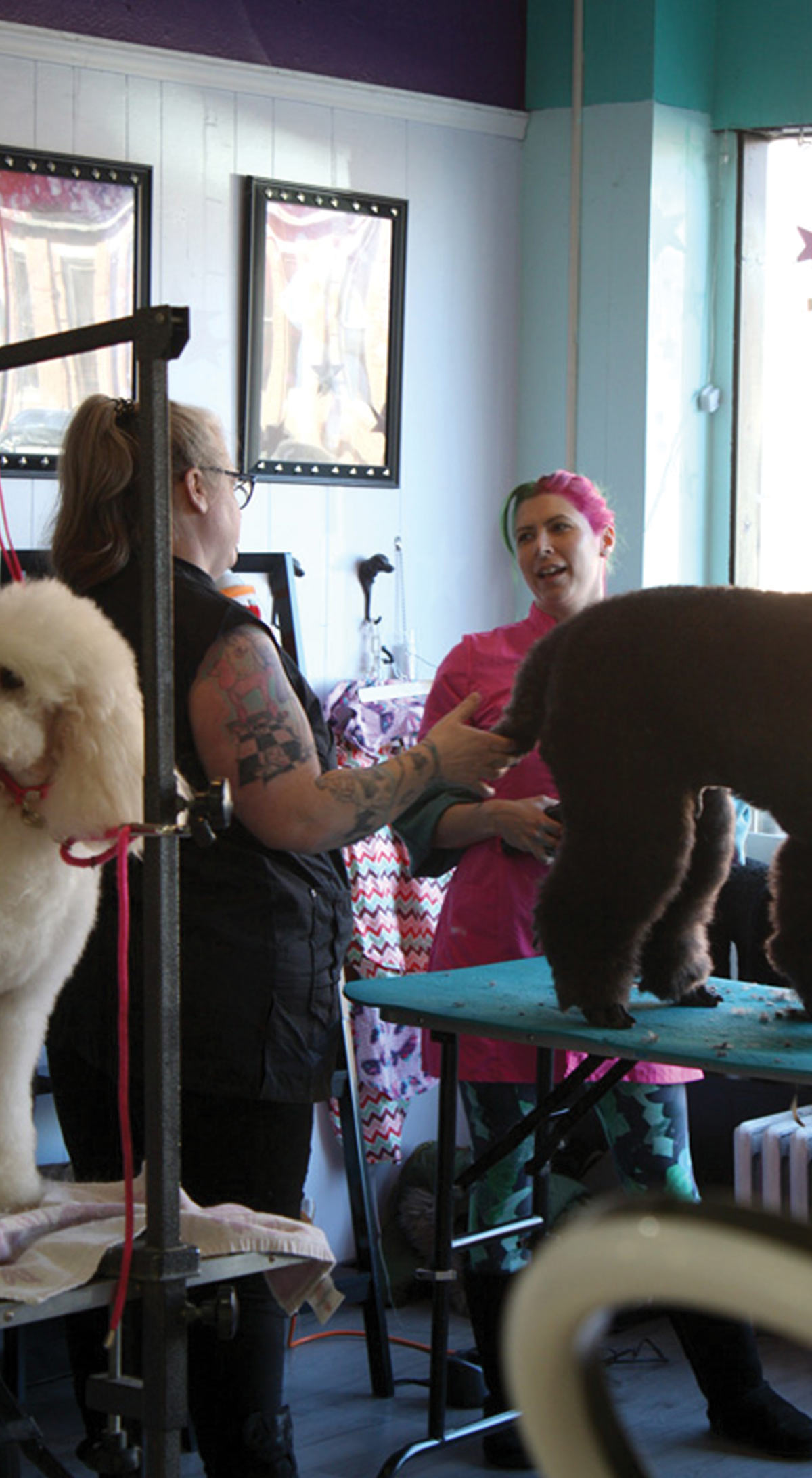
To
You!
“This would be a great time to tell you an anecdote about how arranging to have someone come to my shop to teach was very difficult and of all the things that went wrong,” Liz quipped. “Honestly, though, it turned out not to be very hard at all, and everything went according to plan. I’ve hosted a Pet First Aid class, a dog trainer Q&A, Girl Scouts Pet Care badge event, and two hand-scissoring classes.”
So, who attends these events?
In addition to Liz’s two full-time staff members, she said, “There are quite a few groomers in the area. And I’ve had groomers come all the way from Vermont for a couple of the seminars we have hosted. The groomers who want to learn are willing to do a lot to get that education.”
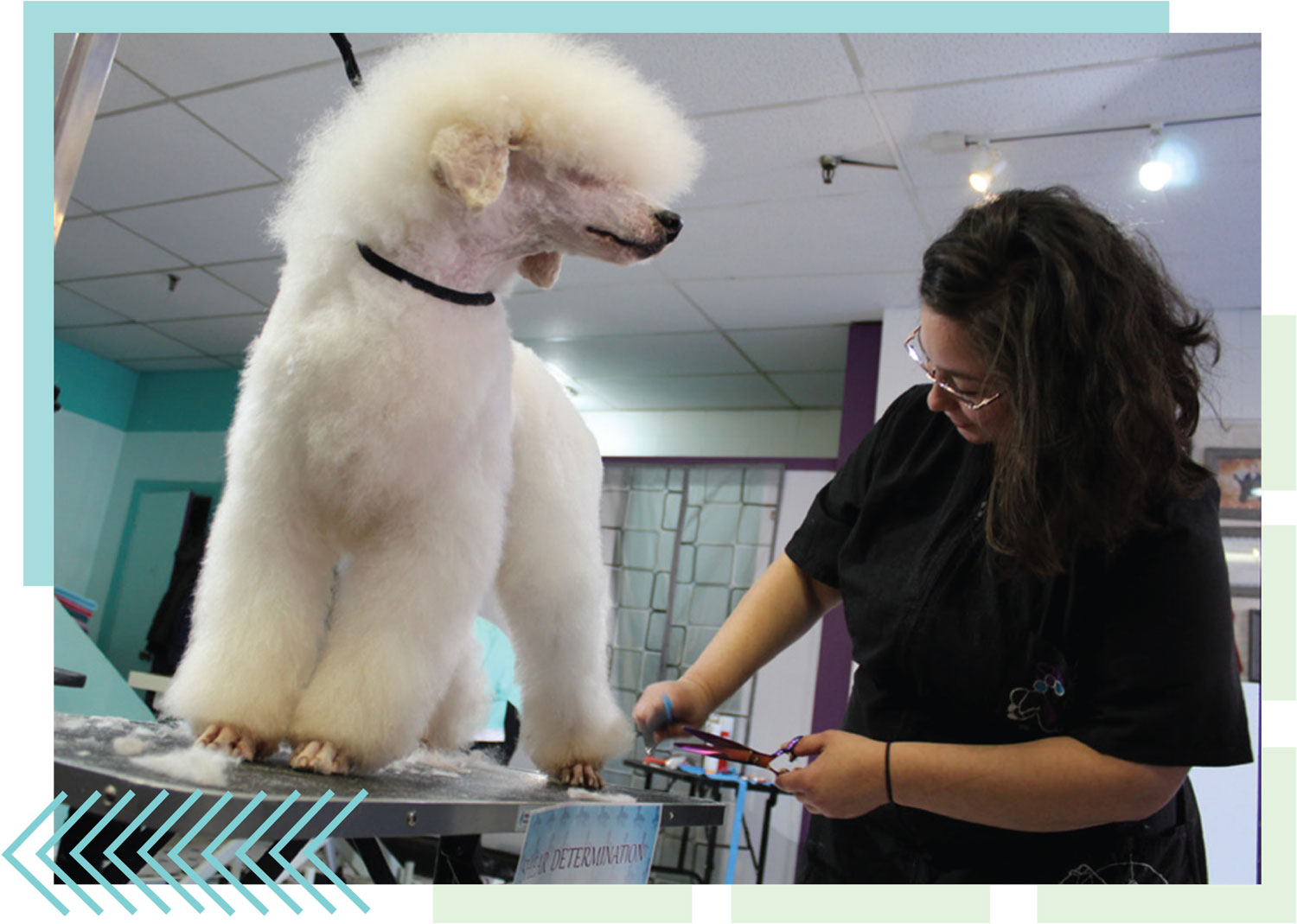
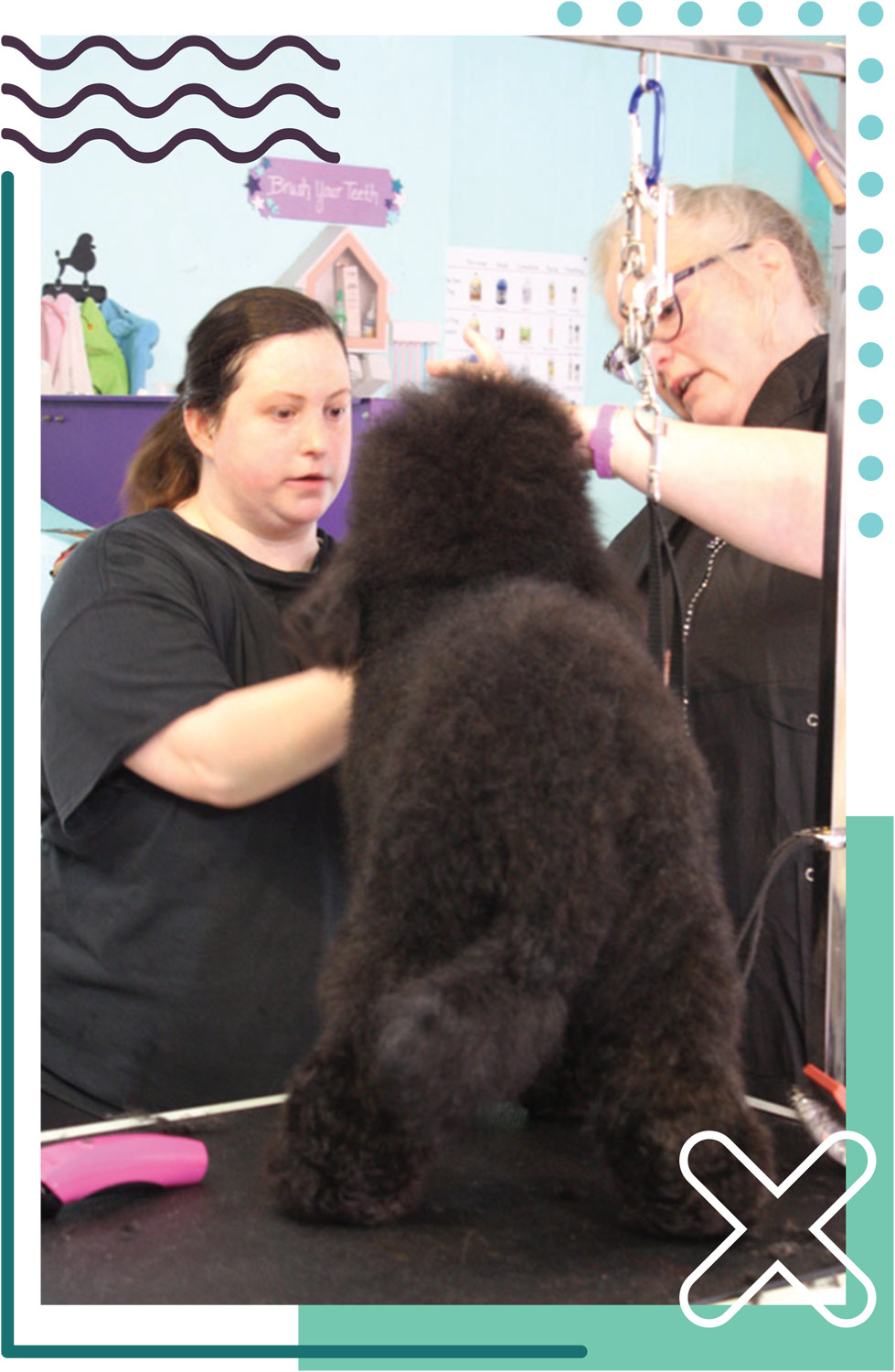

“The absolute best thing about holding educational events is the people you meet. It’s the best way to find like-minded people with your values; people who you get to grow with and cheer on.”
– Liz Jackson
“The absolute best thing about holding educational events is the people you meet,” she added. “I’m not a people person, but all my best friends came from dog educational events. It’s the best way to find like-minded people with your values; people who you get to grow with and cheer on, whether that means you are cheering from the competition audience or cheering from the other side of the salon. After an event, the feedback I get most is, ‘Will you let me know when the next one is?’ I think that is some very positive input towards my efforts.”
In addition, Liz has been able to see how learning new skills affects her business. “The most popular niche service my shop offers is creative color,” she said. “We do anything from tail tips (rainbow tails seem to be a favorite) to full-body color work. And after a year of studying, we are pleased to be offering hand-stripping now, too. Vallery, one of my fabulous employees, has found a passion for it, and it is so cool to see the healthy change in the hand-stripped dogs’ coats.”
With great enthusiasm, Liz shared, “I would absolutely recommend other groomers try bringing educational opportunities to their areas. Social media has made reaching out and connecting with people so easy. Organizing events is easy; advertising events is easy. The hardest part is coordinating schedules. If you are intimidated about asking a groomer to teach a class, remember that they are just a person. Yes, an incredibly talented, successful, industry-leading person, but still a person!”
So, the next time you lament that you can’t work out a way to attend a grooming event, consider emulating Liz Jackson, a groomer from a small town in rural Maine who is making meaningful changes in the lives of fellow industry members in her area.
To conclude, Liz said, “A couple of groomers have said that they see me as the kind of dog-girl who lifts up other dog-girls. That is the person I want to be, and I’m sure hosting educational events is part of that.”
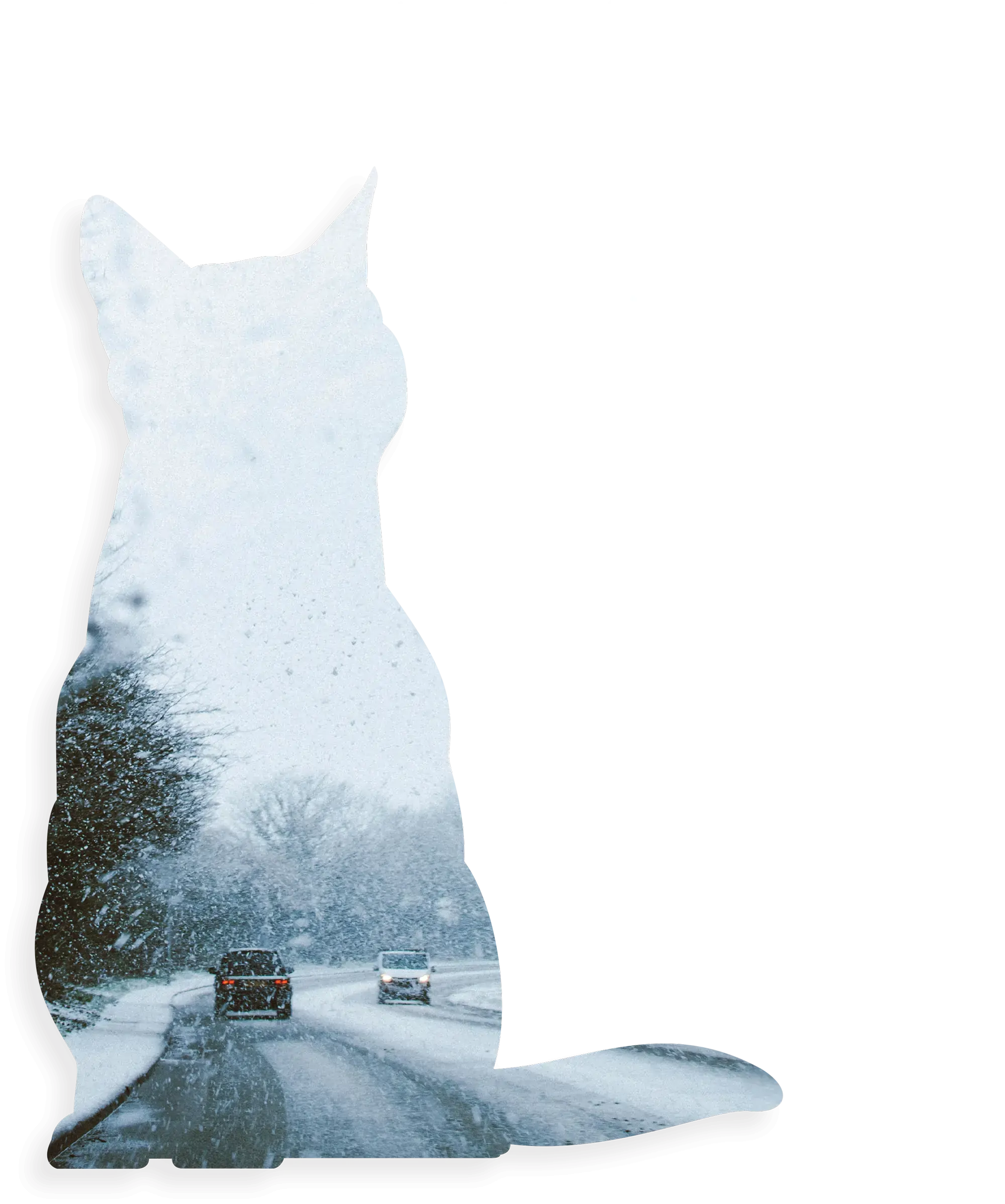
by Lynn Paolillo
 s grooming cats easy?”
s grooming cats easy?”
This is a question I get asked quite frequently, especially about the differences between grooming dogs versus cats. And the answer isn’t a simple yes or no, because I’ve found that saying “grooming cats is easy” is like saying “driving in the snow is easy.” It struck me how grooming cats and navigating snowy roads require a surprisingly similar set of skills. Both demand precision, patience and a deep understanding of the environment at hand.
Preparation Is Key
Before embarking on a journey over snow-covered roads or beginning a grooming session with a new cat, preparation is essential. Just as you wouldn’t drive in the snow without proper tires and emergency supplies, you shouldn’t approach cat grooming without the right tools and mindset. Your salon space should be as ideal as possible with a calm and well-organized environment. Everything should be where you need it, when you need it—just like you wouldn’t forget any of your travel essentials at home before leaving for a trip.
Mental preparation is equally as crucial. Whether facing an icy road or a fussy feline, staying calm and focued is vital. It’s about anticipating potential challenges and being ready to tackle them head-on. When scheduling a cat’s groom, ask additional questions to learn about their potential temperament, any possible pain or previous injuries, and their current coat condition. This information can help to make sure you have the proper environment, you have an assistant if needed, and you have scheduled plenty of time if the cat seems particularly challenging or matted.
You need to read the signs—whether it’s a cat’s body language or a road’s slippery curve— and respond accordingly. This adaptability comes from experience and a deep understanding of the environment you’re working in.
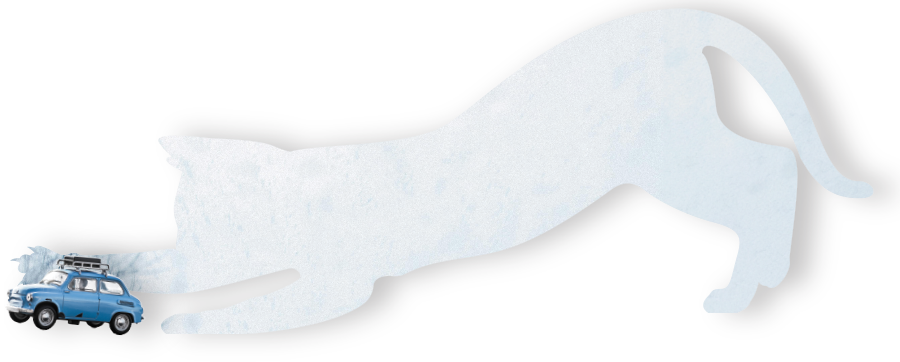
Understanding Your Environment
Every cat, like every winter road, is unique. Just as you must adjust your driving technique for varying snow conditions, you must also adapt your grooming approach to each cat’s temperament and grooming needs. In both scenarios, being observant is key. You need to read the signs—whether it’s a cat’s body language or a road’s slippery curve—and respond accordingly. This adaptability comes from experience and a deep understanding of the environment you’re working in.
Feline body language isn’t as simple as a flicking tail or the direction the ears are pointed. While those are factors, it’s important to look at the animal’s overall stance and movements to get a full picture of what it is trying to communicate. If the cat responds negatively or escalates during handling of specific areas of the body or when moved into a position, then you’ll need to move to something else or try a different approach. Quick escalations can be signs of pain or discomfort, and the best techniques should prevent aggravating cats, both physically and mentally.
Grooming different cat breeds requires an understanding of their specific needs—much like how driving in snow demands an awareness of how your vehicle reacts to different conditions. Both require a steady hand and a gentle approach. Whether it’s avoiding snags in a long-haired Maine Coon or navigating a tight turn on a snowy road, the key lies in your ability to handle situations delicately and thoughtfully.
Patience is perhaps the most critical skill in both these tasks. A grooming session can be longer, especially when dealing with a matted coat or a nervous cat. Similarly, a journey through a snowstorm tests you to remain calm and not rush. Both situations can be frustrating, but the satisfaction of a well-groomed cat or a safely reached destination makes it all worthwhile.
Working methodically and having a solid plan for the cat’s groom will help you with going slowly and carefully, but without taking so long that the cat becomes stressed and impatient due to the length of time. Clipper work especially takes a deft hand to make sure every clipper swipe counts while maintaining safety.

Stay on top of cleaning and maintaining your equipment and tools. Dull and broken blades can lead to skin injuries, and clippers that aren’t serviced regularly can chew and snag hair, leading to frustration for both you and the cat.

Move the skin from the “danger zones” like the armpits and tuck-up by relaxing the cat’s leg and gently rolling the skin to a flat area like the shoulder, side or center of the belly.

Shave in small sections by stretching skin between your thumb and forefinger, and then shaving in between them. This will take longer, but you’ll have much more control and be able to hold the skin flat and firm while shaving more delicate areas or removing mats.

Use your forearm and/or elbow to act as an extra hand to hold or stretch cats who curl up tightly so that you still have your hand free to hold the skin while shaving.
Grooming cats and driving in the snow might seem worlds apart, but they share a surprising number of similarities. Both require preparation, an understanding of the environment, precision in technique and a great deal of patience. Working with an experienced groomer can help you plan and practice staying calm under pressure and tackling challenges with grace.
So, whether you’re navigating icy roads or grooming in your cat salon, remember that success lies in your approach—steady, patient and always prepared for the unexpected.
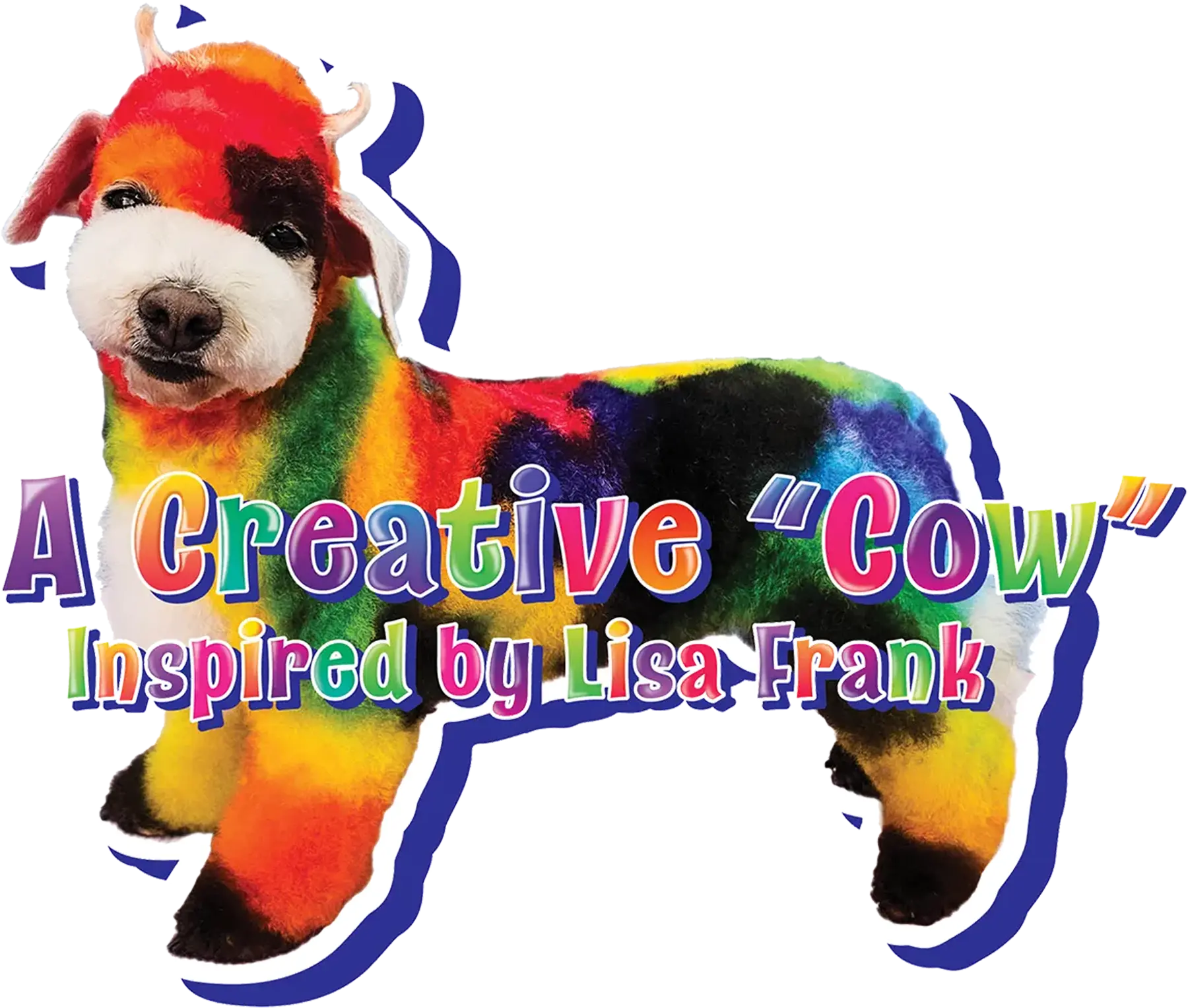
by Blake Hernandez
by Blake Hernandezzz
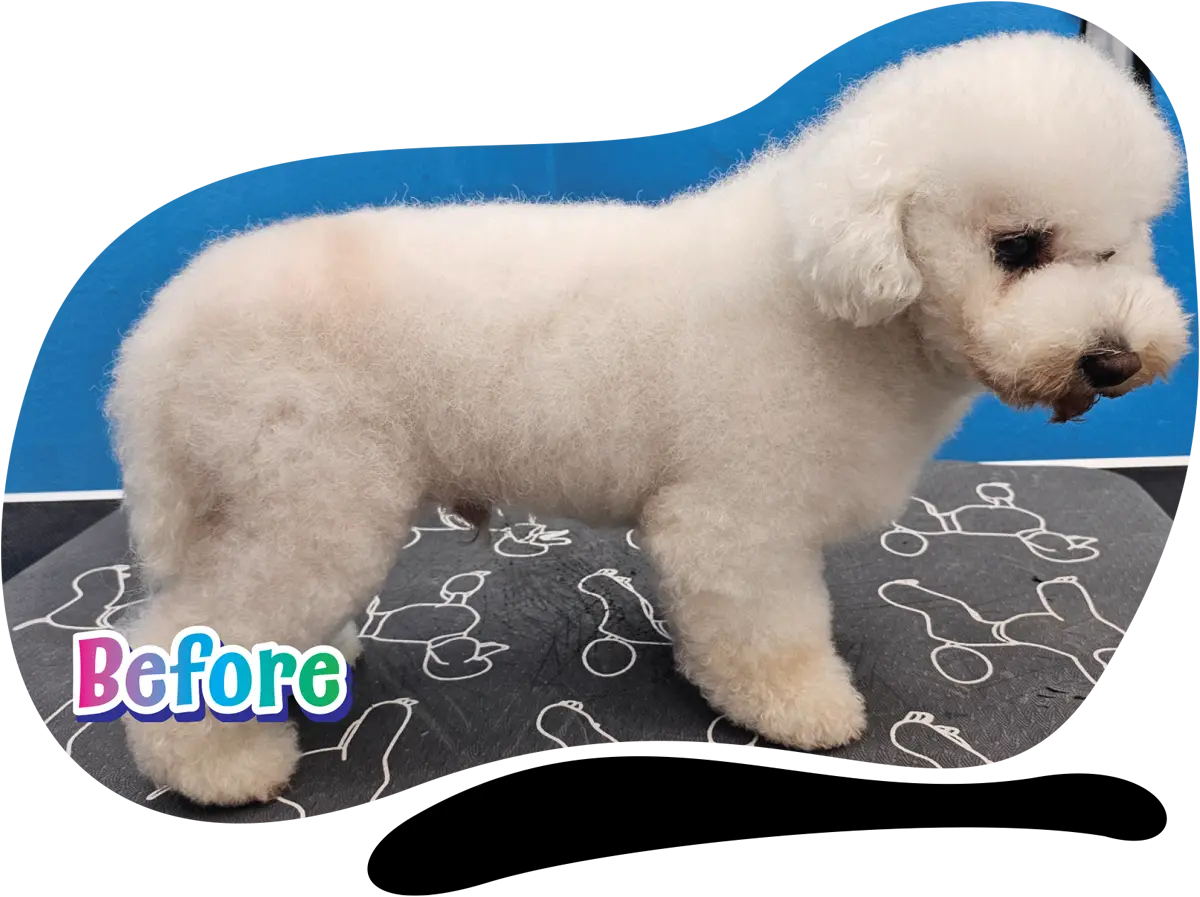
 right colors, tie-dye, and even Lisa Frank art are timeless styles that bring smiles to people’s faces, no matter their age. And the options are endless for creating a unique color palette or animal print all your own! This particular creative groom is for shorter haircuts, so it could easily be done on all sorts of coat types with white or light natural color.
right colors, tie-dye, and even Lisa Frank art are timeless styles that bring smiles to people’s faces, no matter their age. And the options are endless for creating a unique color palette or animal print all your own! This particular creative groom is for shorter haircuts, so it could easily be done on all sorts of coat types with white or light natural color. 
![]() To start, take the coat in tight with a #2 guard comb to get rid of all the excess hair that you won’t be coloring so you aren’t wasting dye. However, you also want to leave just enough on the areas you’re going to keep white so you can trim away mistakes during the final cut.
To start, take the coat in tight with a #2 guard comb to get rid of all the excess hair that you won’t be coloring so you aren’t wasting dye. However, you also want to leave just enough on the areas you’re going to keep white so you can trim away mistakes during the final cut.
![]() You can take the rear in super tight with a #4 guard comb, as cows really aren’t very angulated.
You can take the rear in super tight with a #4 guard comb, as cows really aren’t very angulated.
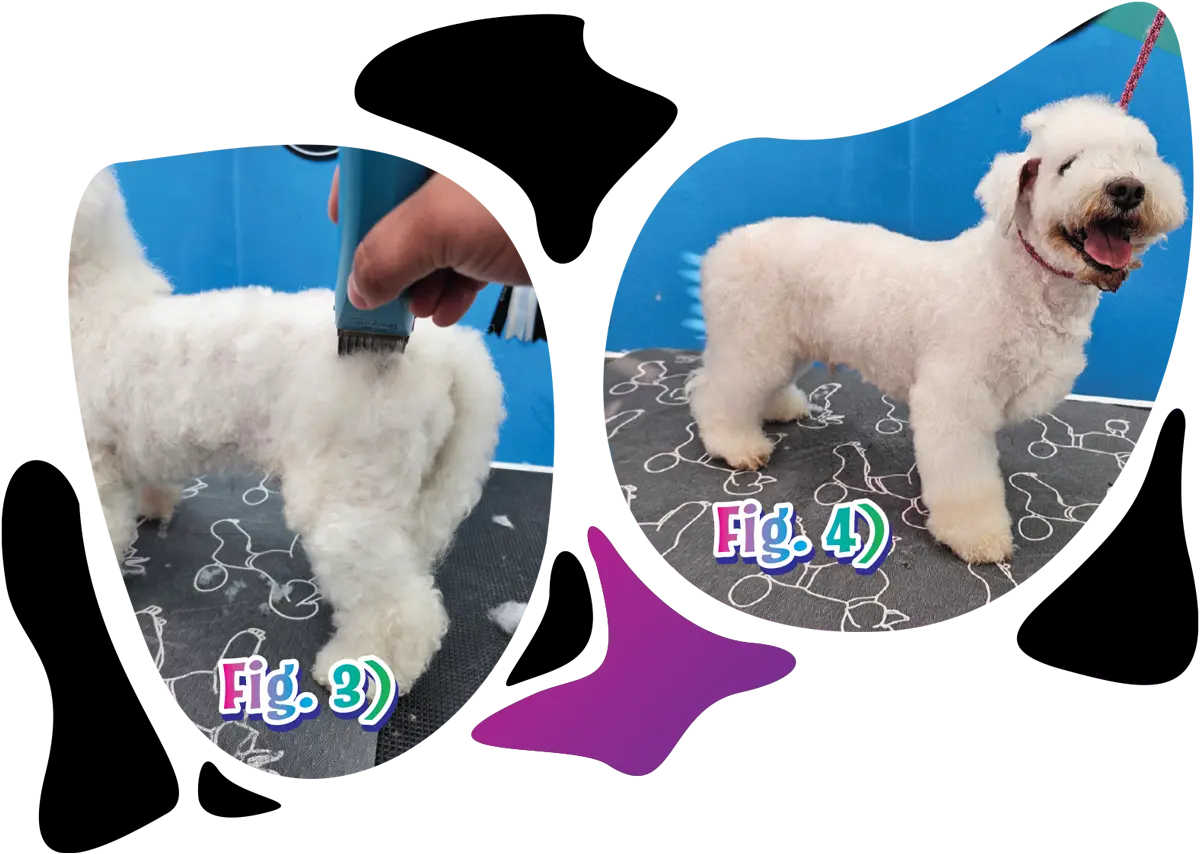
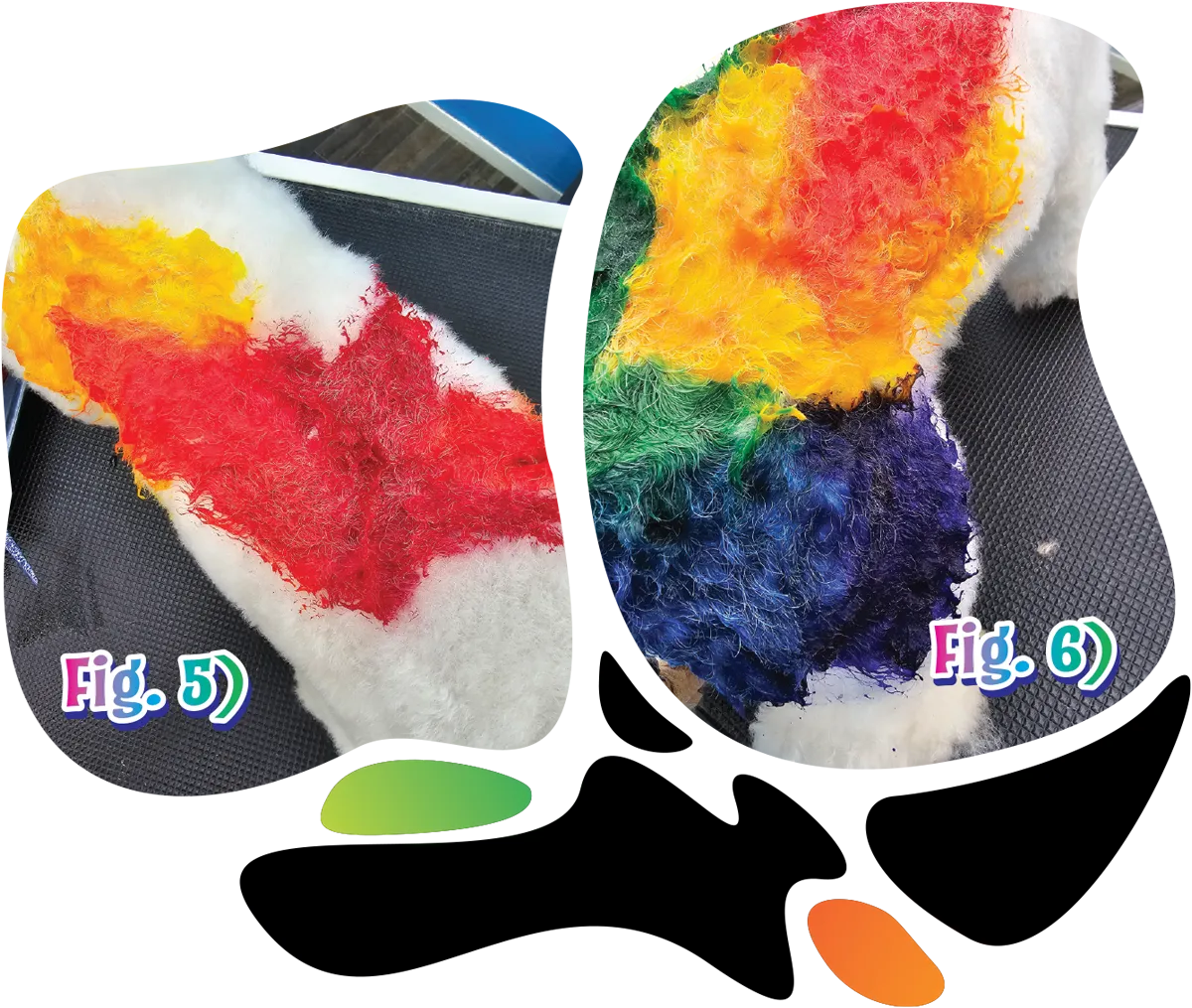
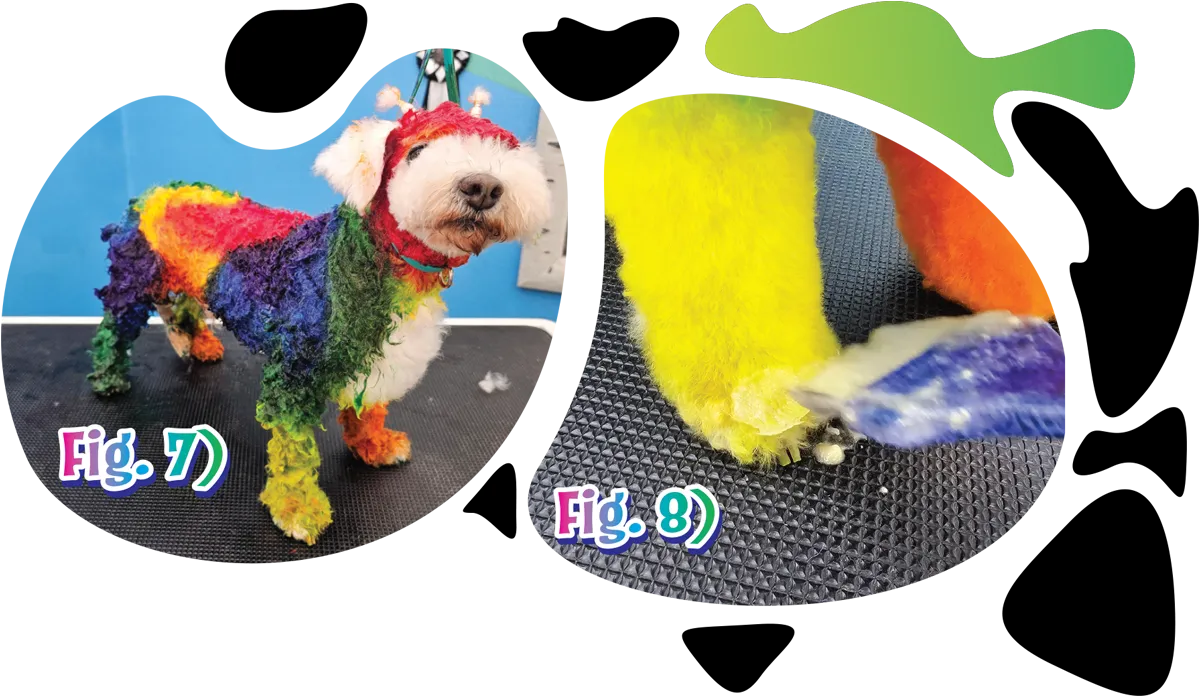


![]() Start from the beginning and even out your trim all over, going short on the body, leaving stuffy legs and creating a lion/cow tail.
Start from the beginning and even out your trim all over, going short on the body, leaving stuffy legs and creating a lion/cow tail.
![]() To finish, create an Asian Fusion muzzle with a small curved scissor in order to set off that cute expression and go short on the ears. For the horns, I used hairspray and wrapped the hair around my pinky to give them the curved look.
To finish, create an Asian Fusion muzzle with a small curved scissor in order to set off that cute expression and go short on the ears. For the horns, I used hairspray and wrapped the hair around my pinky to give them the curved look.


by Anjie Coates
Photo by Anjie Coates
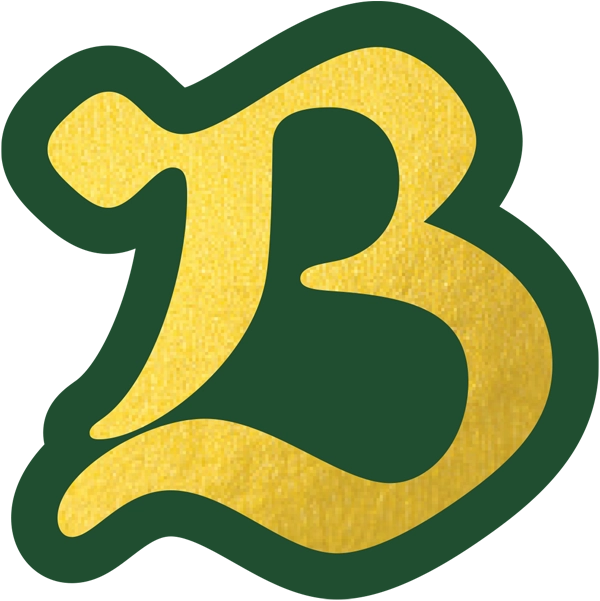 ella is a lovely mixed breed that I’ve groomed regularly her entire life. She was a sweet and somewhat shy pup, but blossomed into a lovely, happy dog. Bella’s Mom was telling me that she has become very sensitive about her feet, which I thought was odd, as Bella was never one to have any issues with her feet or her nail trim. However, they’d just moved to a new house where their lawn wasn’t in yet, and it was mud season in Massachusetts.
ella is a lovely mixed breed that I’ve groomed regularly her entire life. She was a sweet and somewhat shy pup, but blossomed into a lovely, happy dog. Bella’s Mom was telling me that she has become very sensitive about her feet, which I thought was odd, as Bella was never one to have any issues with her feet or her nail trim. However, they’d just moved to a new house where their lawn wasn’t in yet, and it was mud season in Massachusetts.  “Hey, Bella. You ready for spa day?” I ask.
“Hey, Bella. You ready for spa day?” I ask.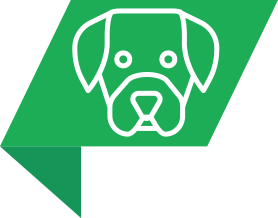 Bella: “I am! We do all the good massages?”
Bella: “I am! We do all the good massages?” “Yes we will!” I assure her. “And as soon as your bath is done, we’ll take a peek at those feet and see what’s going on.”
“Yes we will!” I assure her. “And as soon as your bath is done, we’ll take a peek at those feet and see what’s going on.” Bella: “OK! But my feet are fine.”
Bella: “OK! But my feet are fine.” Nothing seemed amiss in the tub, but figured I could get a better look at her feet on the table.
Nothing seemed amiss in the tub, but figured I could get a better look at her feet on the table. “Ready for your finish?” I ask.
“Ready for your finish?” I ask. Bella: “Yes! More rubs?”
Bella: “Yes! More rubs?” “Yes, more rubs,” I reply.
“Yes, more rubs,” I reply. Bella makes a beeline for my grooming table and hops up, spins and sits with a grin.
Bella makes a beeline for my grooming table and hops up, spins and sits with a grin. “OK, let’s take a closer peek at those toes, shall we?” I say as I pick up each foot and examine every toe closely. But I find nothing, and Bella doesn’t seem to mind me handling her feet at all.
“OK, let’s take a closer peek at those toes, shall we?” I say as I pick up each foot and examine every toe closely. But I find nothing, and Bella doesn’t seem to mind me handling her feet at all. “Are your feet sore?” I ask.
“Are your feet sore?” I ask.
 Bella: “Nope.”
Bella: “Nope.” “But your Mom says your feet are sensitive,” I say.
“But your Mom says your feet are sensitive,” I say. Bella: “No, feet are fine.”
Bella: “No, feet are fine.” “Well, let’s do your nails then, OK?” I ask.
“Well, let’s do your nails then, OK?” I ask. Bella: “OK!”
Bella: “OK!” I get her nails done and she doesn’t even move except to lean against me.
I get her nails done and she doesn’t even move except to lean against me. “OK, what’s going on then, babe? Why are your feet so sensitive at home but fine here?” I ask as I rub paw balm into her pads thinking maybe the snow has made them uncomfortable.
“OK, what’s going on then, babe? Why are your feet so sensitive at home but fine here?” I ask as I rub paw balm into her pads thinking maybe the snow has made them uncomfortable. Bella: “She does it wrong.”
Bella: “She does it wrong.” “Who does what wrong?” I ask.
“Who does what wrong?” I ask. Bella: “Mom. She does it wrong.” And offers me her back foot by sticking it out.
Bella: “Mom. She does it wrong.” And offers me her back foot by sticking it out. “Right. What exactly is wrong?” I ask still confused.
“Right. What exactly is wrong?” I ask still confused. Bella: “My feet. She does it wrong.” And she lifts her other back foot for me to rub the paw balm into.
Bella: “My feet. She does it wrong.” And she lifts her other back foot for me to rub the paw balm into. I grin in realization, and ask, “So Mom is going in the wrong order?”
I grin in realization, and ask, “So Mom is going in the wrong order?”
 Bella: “Yeah! She’s drying both my front feet, one after the other!”
Bella: “Yeah! She’s drying both my front feet, one after the other!” “So she doesn’t do it in the order we do your feet every time?” I ask as I suppress a laugh.
“So she doesn’t do it in the order we do your feet every time?” I ask as I suppress a laugh. Bella: “Right. I tried telling her. She didn’t understand.”
Bella: “Right. I tried telling her. She didn’t understand.” “Well, I will explain it to her. She doesn’t know my order—our order—it’s not her fault,” I reassure her.
“Well, I will explain it to her. She doesn’t know my order—our order—it’s not her fault,” I reassure her. Bella: “OK, good. Because there’s only one way.”
Bella: “OK, good. Because there’s only one way.” Calculating how many hundreds of times I’d done Bella’s nails over all these years I nod, realizing that for her, there was only one way she’d done this for her entire life. And now with all the mud in the new yard, she needs her feet wiped all the time.
Calculating how many hundreds of times I’d done Bella’s nails over all these years I nod, realizing that for her, there was only one way she’d done this for her entire life. And now with all the mud in the new yard, she needs her feet wiped all the time. “How about I write down the order you prefer for your Mom so that she’ll never forget?” I ask.
“How about I write down the order you prefer for your Mom so that she’ll never forget?” I ask. Bella: “You promise?”
Bella: “You promise?” And I reply,
And I reply,
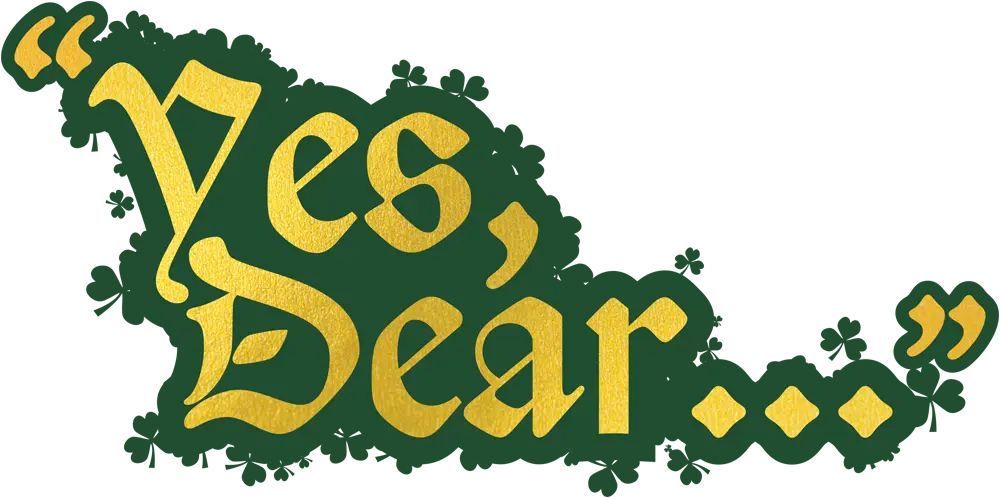



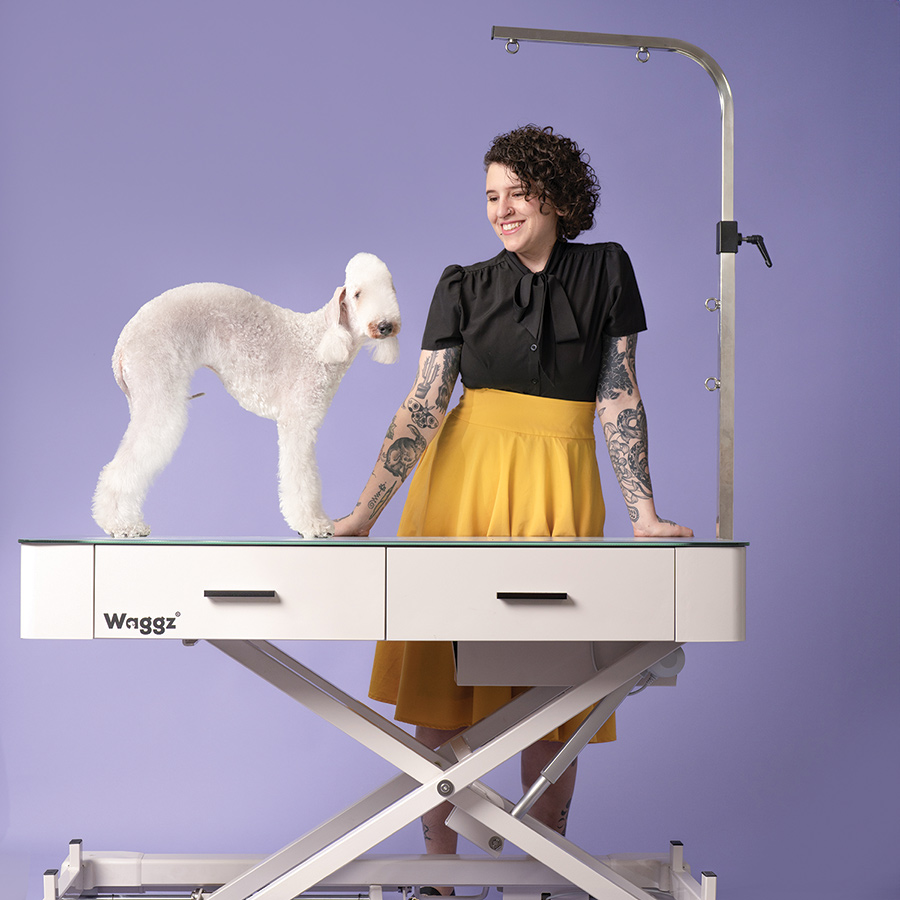
Call
(717) 691-3388 ext 224 to place a Classified.
Rates: 25 words or less $50.00
$2.00 each
Classified ads must be prepaid.
Call for issue deadlines.
Agency discounts do not apply.



